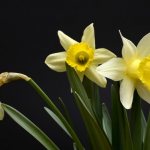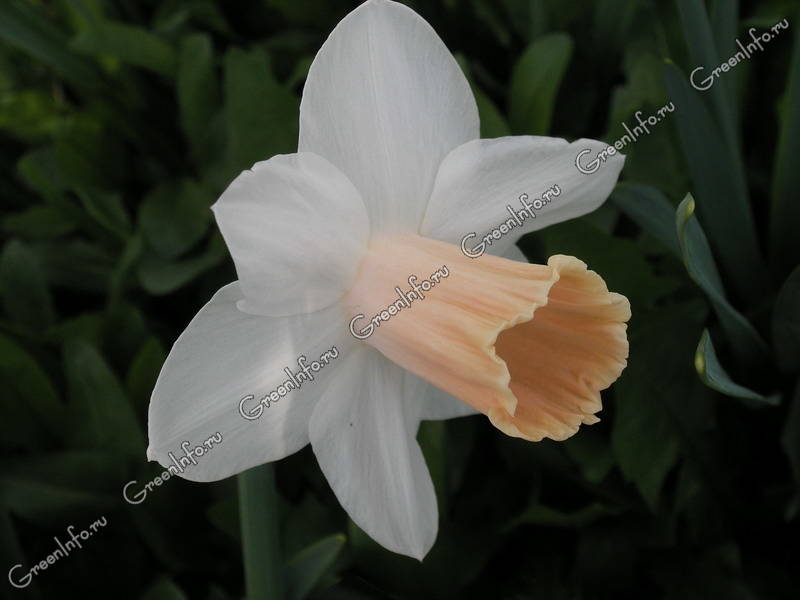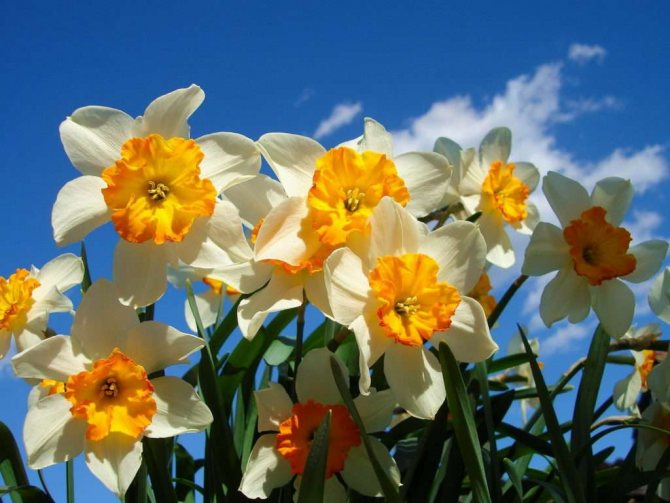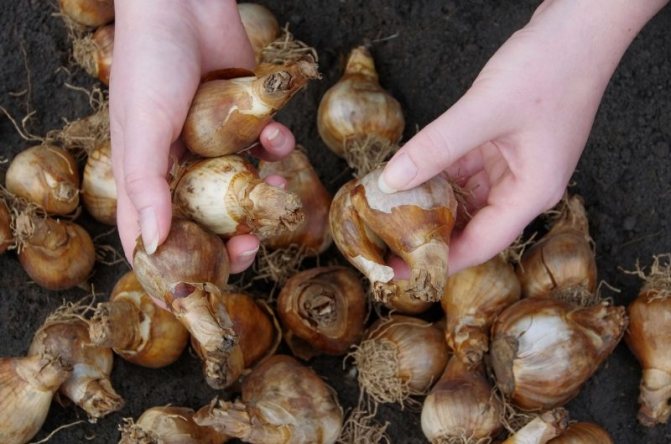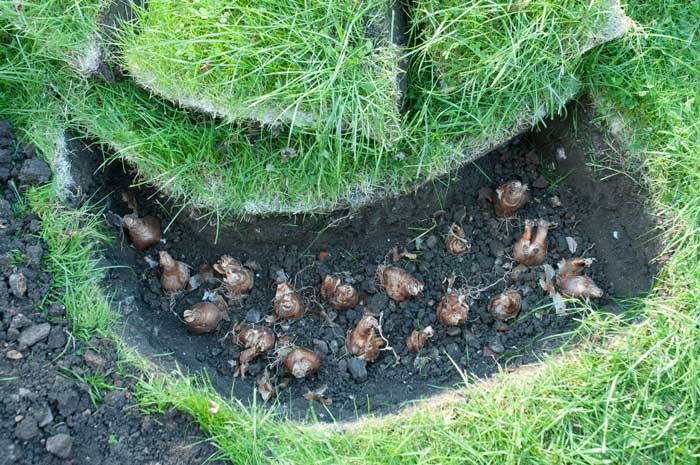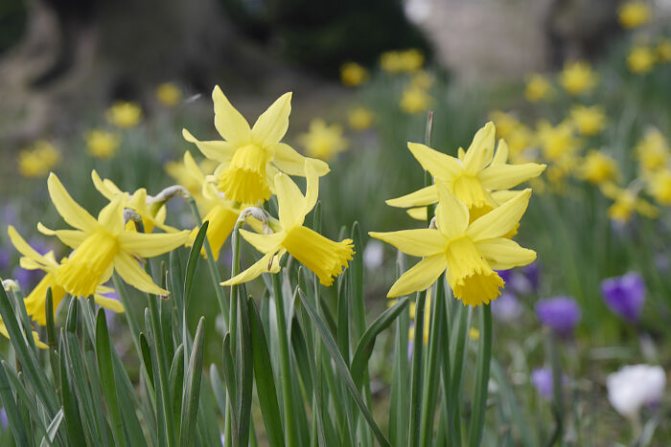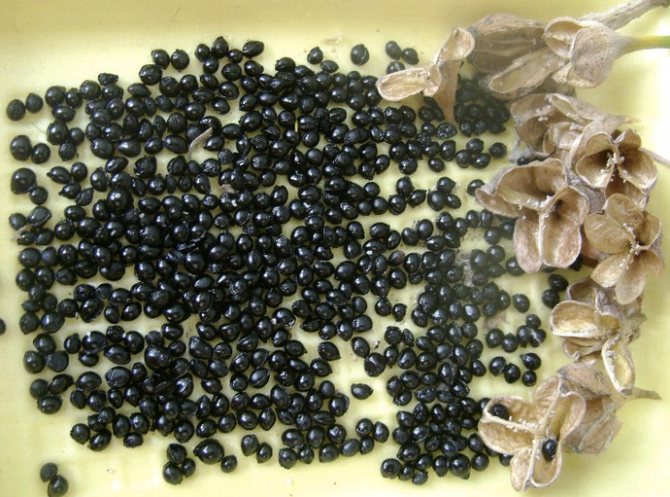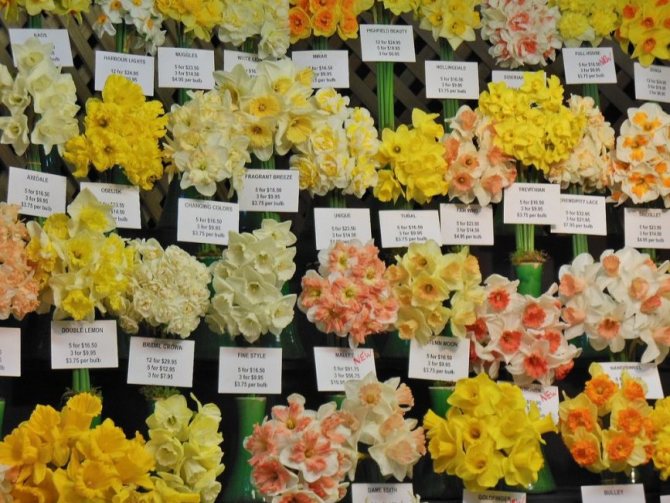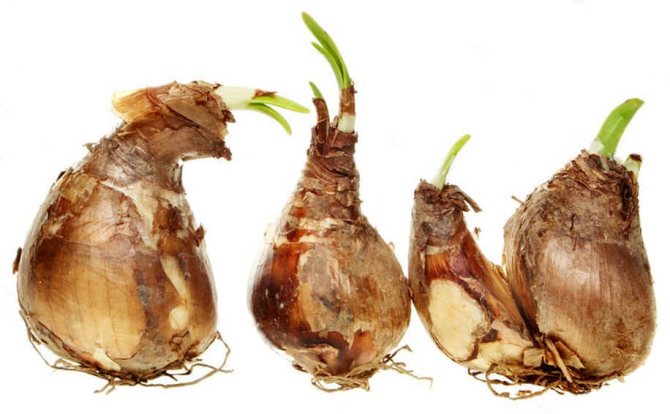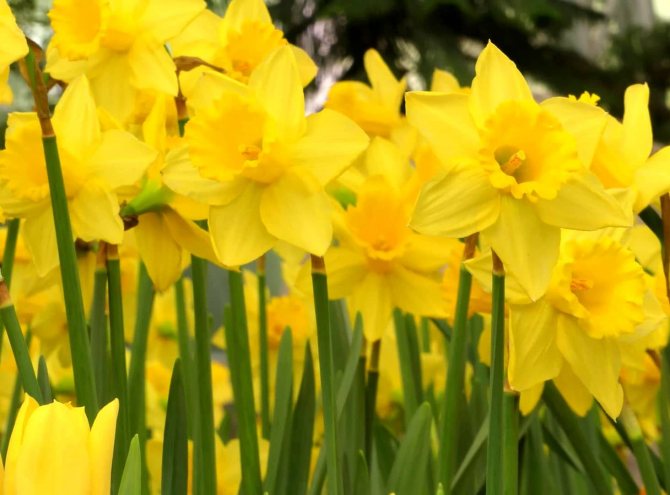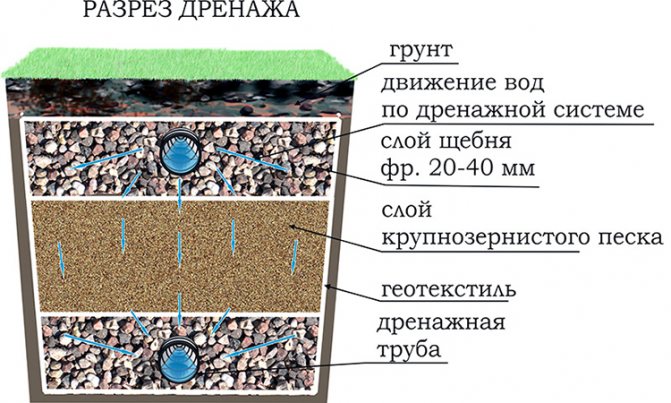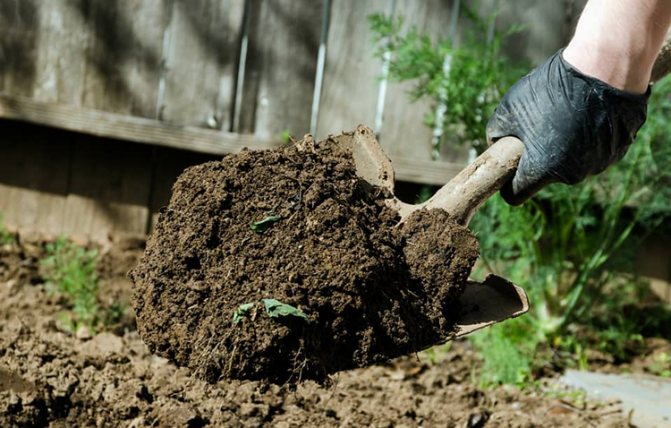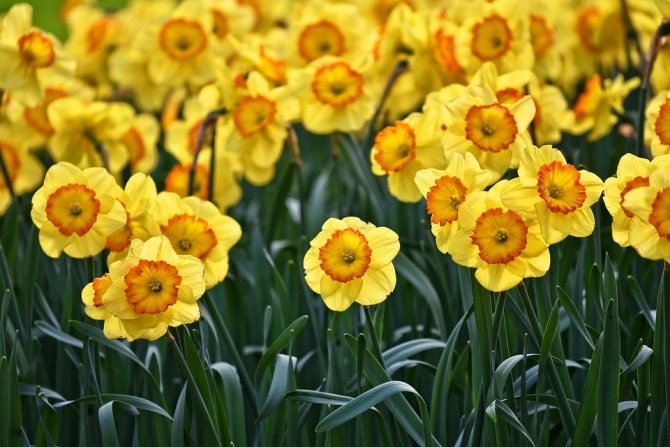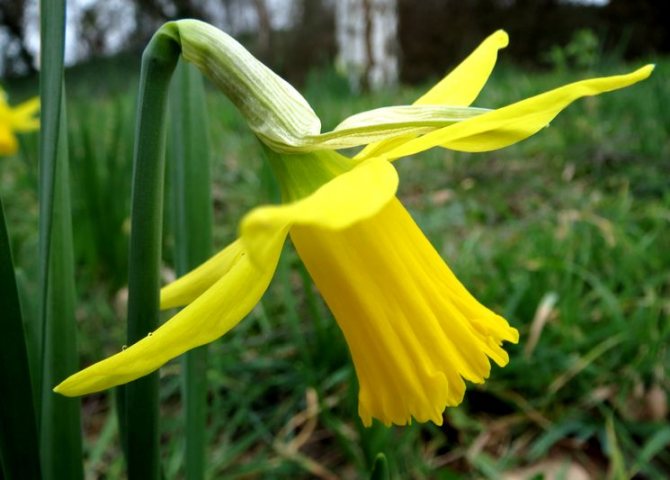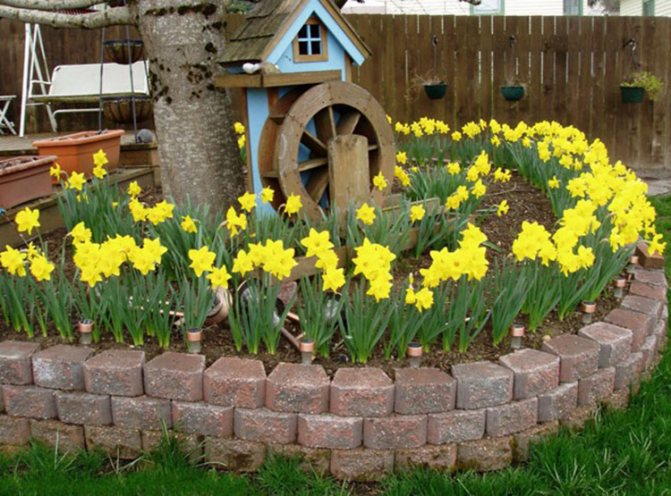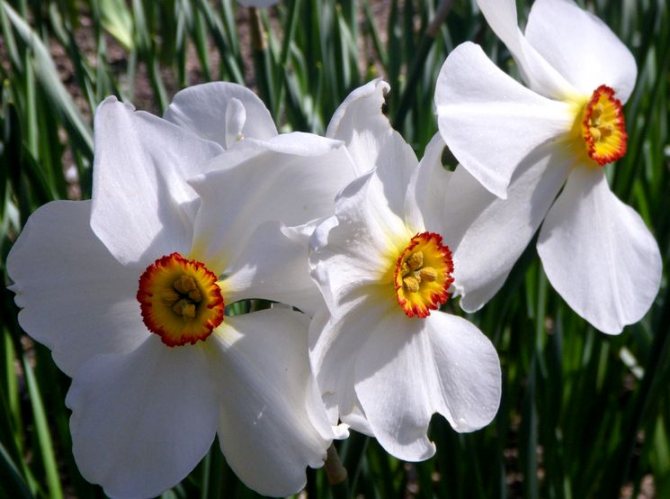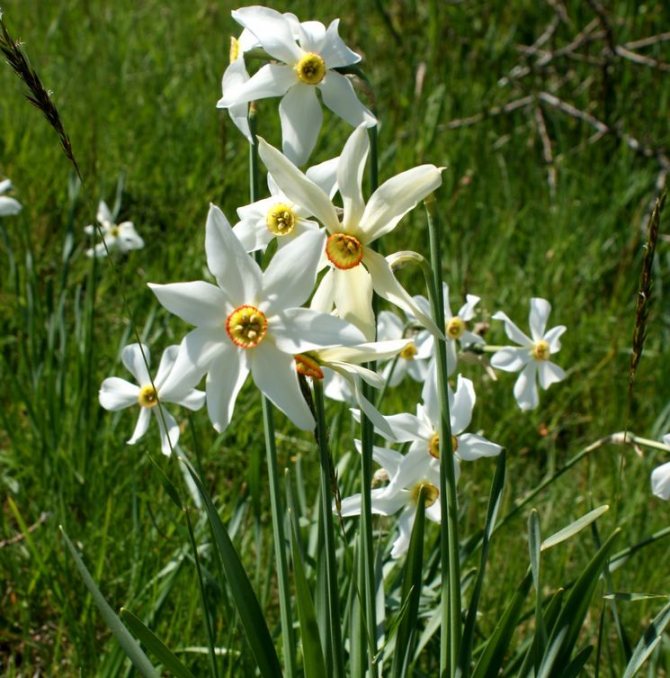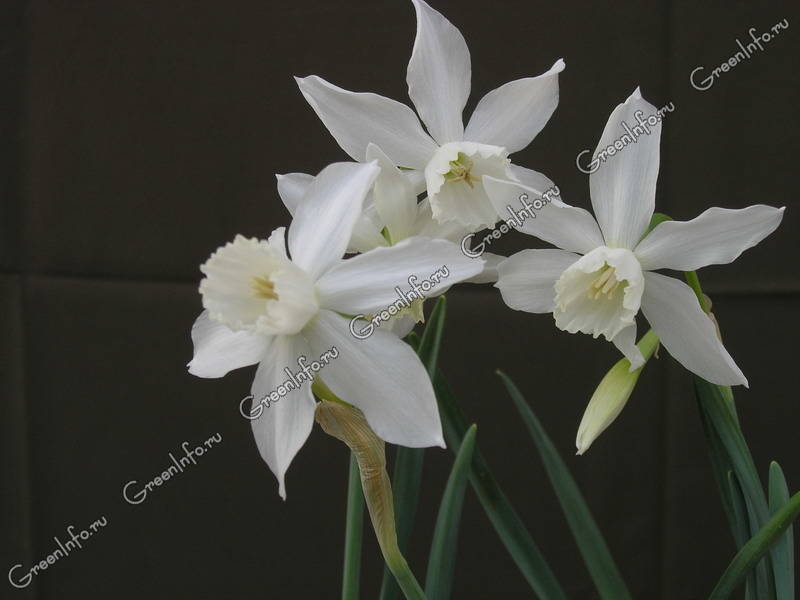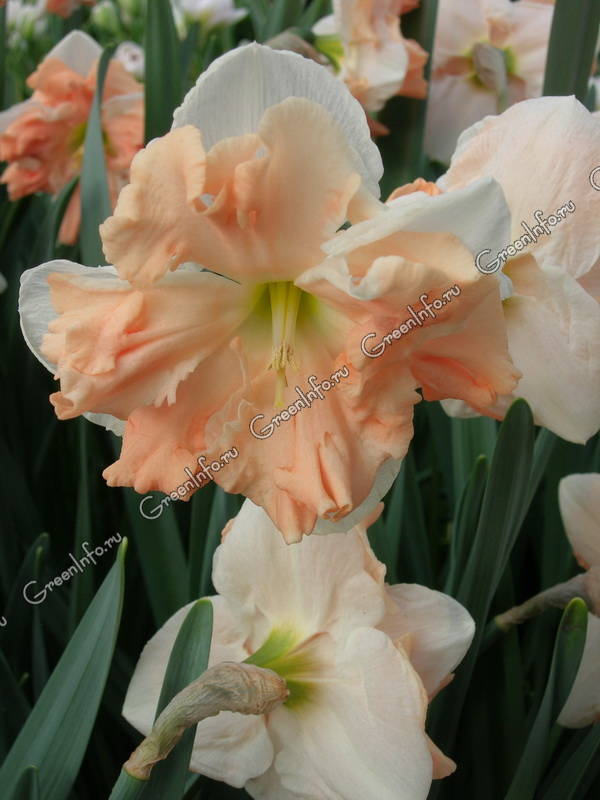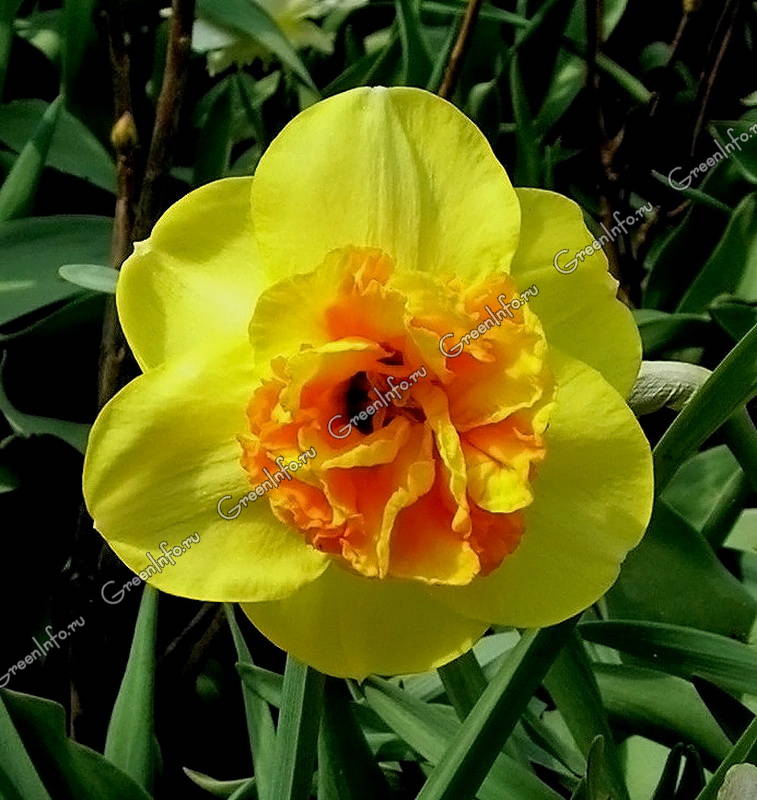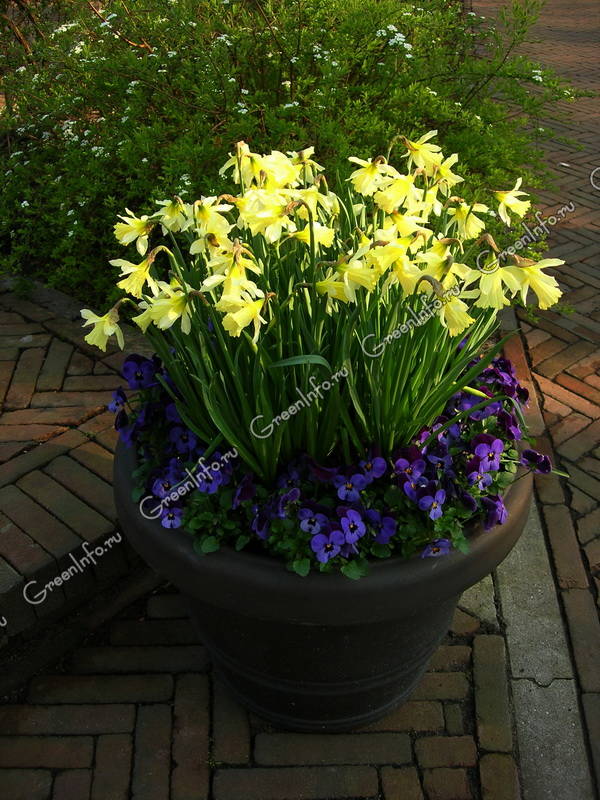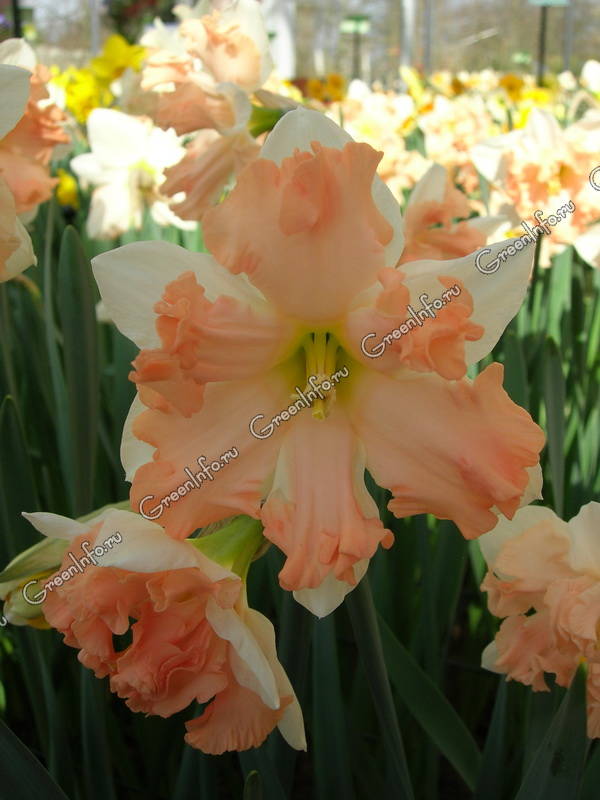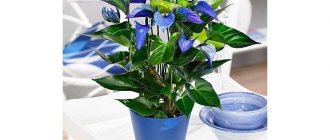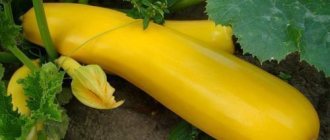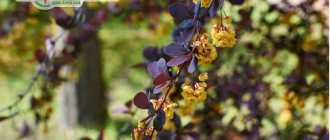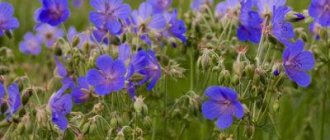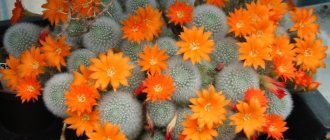Daffodils are among the earliest flowers to bloom in spring. The recognizable buds, consisting of 6 petals with a round crown in the center, adorn many garden areas, delighting everyone with a pleasant aroma and graceful beauty. They are quite unpretentious and in street conditions do not require any annual digging or special maintenance. Growing these flowers in a pot will decorate any house or apartment, and will also allow you to get a fragrant bouquet not only in spring, but also in other periods of the year.
Planting daffodils: when and how to plant
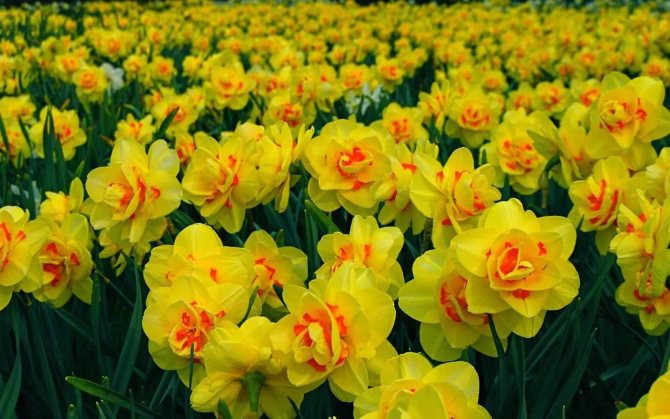
Daffodils are not capricious flowers and even a novice florist can cope with their cultivation. The flower is not picky about the soil, however, some features of the plant should be considered when choosing a place for planting. There is an unequivocal answer to the questions of when and how to plant daffodils, plant in the fall, in a quiet area, well-lit by the sun. Daffodils are unique flowers and will adapt to any type of soil. Still, there are some conditions that must be observed when planting some of their species.


So, the landing time is determined purely individually, and depends on the climatic latitude. Planting daffodils in the fall in open ground can last from August to October, the main thing is that the soil does not cool down and keeps the temperature at + 9-12 degrees. Before the first frost, the daffodil bulb should have time to take root and begin to grow.
Selection of bulbs
To get beautiful healthy flowers, you should take care of the choice of material for planting. Seeds are rarely used for this, but the process of growing it is very long and laborious. In most cases, bulbs are taken for these purposes, separating babies and mothers. When buying them from third parties, you need to pay attention to the following criteria:
- large material will give stronger shoots;
- roots that are firm to the touch will ensure the healthy development of plants;
- soft and rotting areas may indicate the presence of disease or improper storage;
- spots and damage provoke the multiplication of bulbous parasites.
Purchased bulbs should not be stored for a long time and it is better to plant them in containers as soon as possible. If necessary, they can be placed in a dark, dry and ventilated place for a while. Otherwise, there is a risk of fungal infection or premature establishment.
How to properly cultivate the soil for planting daffodils
Daffodils grow well on loamy soils, this does not mean that the flower will not grow on fertile soil rich in humus.
Daffodils, like all garden flowers, prefer fertile soil, rich in humus, with a neutral acidity level. But excessive aeration and light sandy soils are not suitable for planting daffodils, since the bulb can freeze in winter and dry out in summer, without proper care.
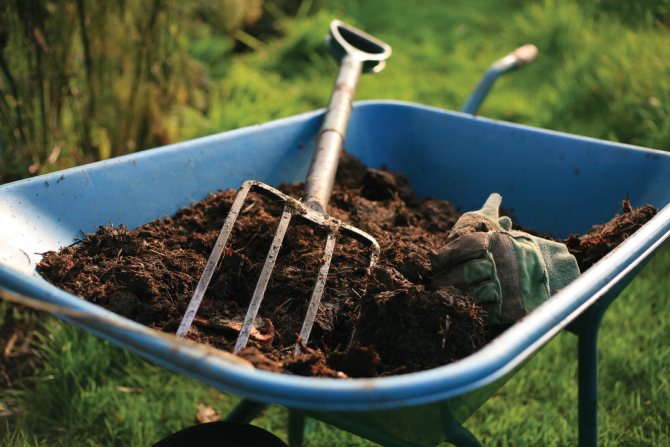

It is not difficult to correct the soil soil on your own: in poor loams, add black soil (1 bucket per 2 sq.m.), lime and nitrophosphate (150-200 grams per 1 sq.m.); Mix light sandy soil with black earth and clay in equal proportions, apply nitrogen fertilizers and potassium, heavy and clogged soil soils are artificially lightened by river sand (15 kg per sq. m.) and peat. Organic fertilizers are applied to the soil, a year before the planned planting of the plant on the site, in order to avoid scalding the daffodil bulb.
Mr. Summer resident warns: diseases and pests of indoor daffodils
When growing flowers, you can face many problems. Among them, the following are most common:
- Fusarium fungus infection occurs with abundant watering, an excess of ammonia fertilizers, and keeping the onions warm and damp. To prevent disease, they need to be properly maintained, and also treated with fungicides before each planting. In the presence of a disease, plants and onions are discarded and destroyed.
- The large daffodil fly lays eggs in the roots. From them, larvae appear, feeding on the pulp of the onions and leading to their decay. To identify them, you need to put pressure on the spine, it should not be pressed at the top. The contaminated material should be treated with karbofos or held for a couple of hours in a saucepan with hot water, keeping the temperature in it no higher than +43 ° C.
- Bulbous aphids appear under dry scales and feed on rhizome juices. This softens it, makes the plant sluggish, worsens flowering. To eliminate the parasite, heat treatment in hot water is necessary, as in the case of a fly.
- Gray rot (botrytosis) affects the leaves, leaving silvery and brown spots on them, then penetrates the rhizomes. Fungal spores develop when the air is too humid. To combat, 2 times a month, the infected areas are sprayed with Bordeaux liquid 1-1.5%, a solution of captan 0.5% or a copper-soap mixture (2 g of copper sulfate and 20 g of green soap). The roots are treated with 0.2% foundation.
- The onion mite lives in the soil and enters the bulb through damage. Plant growth stops, flowers and leaves wither. Damaged onions must be removed, healthy ones must be treated with heat.
- Nematodes feed on the juices of leaves and peduncles, from which they pass into rhizomes. They struggle with it by heat treatment with water of + 40 ... + 50 ° C, in which the material is immersed for some time.
Infection often occurs due to insufficiently disinfected soil that is collected in the garden. In this case, sanitization of the substrate will be required. In addition, for the prevention of diseases of narcissists, you should adhere to the following rules:
- regularly loosen the ground and remove dry and sluggish leaves in a timely manner;
- prevent waterlogging of the soil by creating drainage and balanced irrigation;
- create optimal conditions for planting material, store it at a temperature not exceeding + 10 ° C.
Considering all this, many of the problems with growing daffodils can be avoided. And then the blooming windowsill will delight the eye for more than one day.
Optimal planting depth for daffodils


The planting depth of a flower primarily depends on the variety and size of the daffodil bulb. Experienced gardeners say that planting the bulb at a depth of three times its size can be considered the optimal deepening. Thus, for large bulbs, the optimal depth will be about 22 cm, and small bulbs can be planted to a depth of 11 to 16 cm. Larger planting material will give early flowering, and to distill the bulb ahead of time, plant it 5-8 cm . higher from the obtained, when calculating the depth.
Conditions for growing a daffodil in a pot
This plant is one of the most unpretentious to maintain. But to get beautiful and fragrant buds, he should provide an environment that is as close to natural as possible. To do this, you need to adjust the temperature indicators, room illumination and air humidity in it.
| Factor | Conditions |
| Location / lighting | The place should be chosen away from the capricious plants, which can be harmed by the toxins secreted by the narcissus. It should be sunny or lightly shaded for abundant and long-lasting flowering. But direct sunlight is best avoided to prevent burns. |
| Temperature | After planting, cold treatment is required at + 3 ... + 9 ° C, in the first days of adaptation of embryos and during the flowering period around + 10 ... + 12 ° C, and during the rest of the growing season no higher than + 15 ... + 18 ° C. |
| Humidity | For full growth and development of at least 70%, especially after forcing the buds. Heating radiators dry out the air, so the plant should be removed from them, and a container filled with water can be placed next to it. |
Planting daffodils in the fall or the main rules for planting bulbs


With the preparation of the soil and the choice of a site before planting, you have decided, now you need to form holes for planting.
Multiply the height of the bulb by three and get the planting depth, take into account the fact that the soil freezes in winter, it is better to deepen an additional 5 cm than to lose the bulb during wintering.
Before planting, the bulbs are carefully inspected for the presence of affected areas, soaked for a minute in a weak solution of potassium permanganate, dried with a paper towel.
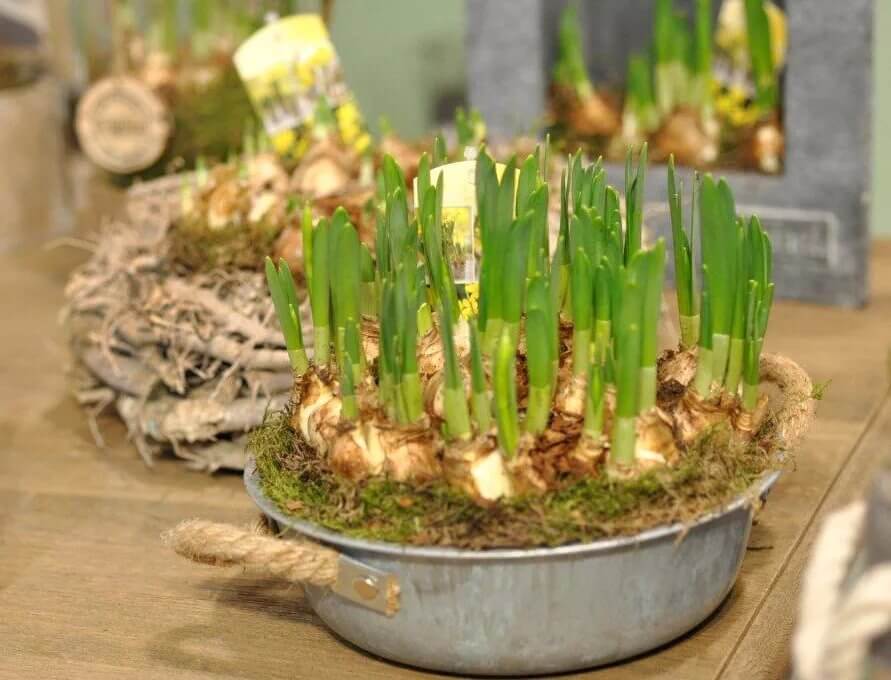

At the bottom of the hole (for drainage), pour 1 cm of river sand, lay the onion with the root down and press down slightly so that the onion takes root better.
From above, the bulb is crumbled with ash and covered with soil in half, the next part of the soil is mixed with phosphorus and potassium and poured into the hole, the surface is slightly pressed down and watered abundantly.
Reproduction of daffodils


There are several ways of reproduction. The procedure is combined with an autumn daffodil transplant.
Seed reproduction
Without loss of traits, only species, natural plants reproduce by seeds. Hybrid varieties lose the properties of the parent plant and show signs of simple initial species.
To collect seeds, the flower is left on the plant until flowering. Very soon the ovary becomes noticeable, and soon the fruit is a triangular box. At the first signs of ripening, when cracking spots are outlined, the peduncle is removed and transferred to the room. There, the box starts to open. Seeds are harvested without waiting for complete drying, and immediately sown in open ground. Seedlings appear next spring or summer. Species seedlings bloom for 3 - 4 years, and hybrid ones - for 5 - 7.
Bulb propagation
The most common and uncomplicated breeding method. When digging a nest for a transplant, it turns out that instead of a once planted one bulb, there are several quite mature and a large number of small ones. The nest is carefully divided, ripe bulbs are separated without difficulty or damage. Planting material is checked for visible signs of disease, disinfected, dried in a warm place and seated, donated, sold. Ripe bulbs in the soil bloom in the next growing season.
Reproduction by children
Usually, when transplanting and dividing the nest of bulbs, small unripe baby bulbs simply crumble on the ground and are lost in it. It is not surprising that after some time an adult daffodil blooms in the most unexpected place - it means that a nest was once carried here. The children can be left on the mother plant so that they grow up and reach the size of flowering, or they can be separated and planted in a school - a drawing bed, where they will grow up, waiting for transplantation to a permanent place. Children bloom in 2 - 3 years.
Reproduction by scales
As such, daffodils do not have scales, the bulb is solid, dense, without the use of special techniques, it does not disintegrate into separate parts. Occasionally, a method of reproduction is used by dividing the bulb. If it is necessary to multiply a rare variety, this may be justified, but there are also risks of losing a single specimen.
The onion is divided, without cutting the bottom, into 2 - 4 parts. It turns out that there are 4 onions on one bottom. The slices are dried, the material is placed in the bottom in a humid environment, for example, moss. After a while, numerous children should appear around each part.They are also grown to obtain numerous plants. After the separation of the children, parts of the bulb can be planted in open ground and grown to the size of flowering. With this method of reproduction, the cut parts may rot or dry out, as well as the death of some children.
Fortunately, daffodils grow quite well without surgery, so this method is rarely used.
Daffodil care
Caring for daffodils in the fall in the open field should be aimed at creating conditions for the rooting of the bulb and protection from the upcoming frost. Fertilization during the hibernation stage of the plant is not required, unless, of course, you followed the rules for planting daffodils and applied fertilizer in the proper amount before planting.
Watering in the fall is also not required, but if the fall is dry and warm, weekly watering is encouraged. For the winter, the area with daffodils is covered with mulch or spruce branches, and cleared in early spring.
Caring for daffodils consists of watering, weeding, hilling and fertilizing the plant. Fertilizers are applied during the formation of the peduncle. Watering in early spring is not required, since the soil has been saturated with moisture since winter; during flowering, daffodils are watered once a week.
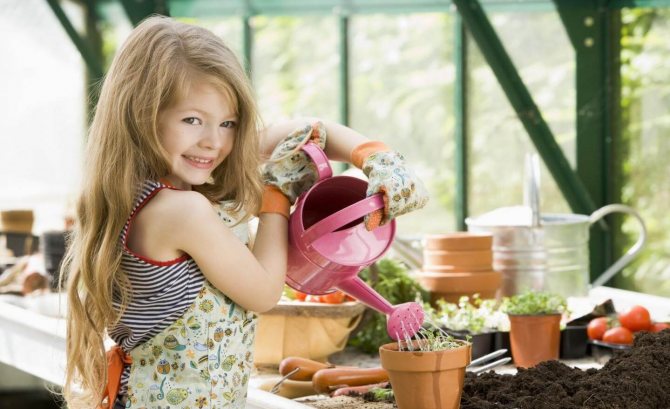

Weeds are weeded as soon as they appear. Hilling should be done as needed, carefully so as not to damage the bulb and the newborn plant. In harsh winters, daffodils need extra cover: a layer of peat, straw, or dry foliage is fine.
Daffodils are planted every 5-6 years, the bulbs are dug up, separated, dried and transplanted to a new place. Difficult and small babies are left with the mother's bulb. The transplant is carried out when the plant has completely bloomed, in August, September.
The bulbs do not need to be dug up for storage every year, but they are perfectly stored in a dark, cool and dry place until next year. Before planting, the bulbs are sorted out and soaked in a manganese solution.
Narcissus Tete-a-Tete
This variety of daffodil is classified as a cyclamen. It was bred as a separate culture in 1585. Plant height does not exceed 25 centimeters. There is one flower on the peduncle, which is very different from other species: the petals are sharply directed upwards, while the bud itself and the inner crown are lowered down. The color is bright yellow.
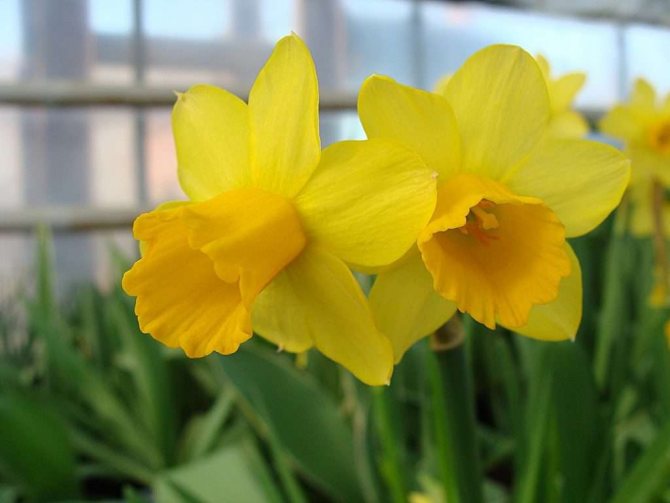

Flowering begins in early May, which is earlier than other varieties. The aroma of the flower is pleasant. When leaving, it is important not to allow the soil to dry out too much, since this daffodil does not tolerate drought. Usually planted near curbs or low fences. Able to rapidly expand its population by releasing new ball-shaped bulbs. During the winter, the plant is dug out of the ground and stored in the basement until the onset of heat.
Species of daffodils, their varieties and features
Narcissus has about a dozen species and more than 20 thousand varieties. They are common in most countries with temperate climates. In the wild, it is found in Europe, Russia, the Alps, Asia.


The history of the origin of the name of the flower rests on the legends of Ancient Greece, in one of which, the Ancient Greek goddess Nemesis punished a young man, at the request of the nymphs he had rejected, and he, seeing his reflection in the water, froze from love for himself and turned into a flower.
The color of daffodils varies depending on the variety and species, classic shades of white and yellow. Basal foliage, width and length also depend on the variety. The bulbs are scaly, brown, oval-elongated. The daffodil flower is bright, decorative and unpretentious, therefore it is gaining more and more popularity.
Note to the florist
- Cut daffodils do well in very cold water. The water is changed daily, the stem is trimmed by half a centimeter.Other flowers react poorly to the neighborhood with a daffodil in one vase - they are oppressed by the milky sap released from the peduncle.
- All parts of the plant, when damaged, secrete a poisonous milky sap.
- After the flowering of daffodils, it is good to plant annual marigolds in their place - they prevent the appearance of many diseases on the bulbs, heal the soil around the plant.
Terry daffodils
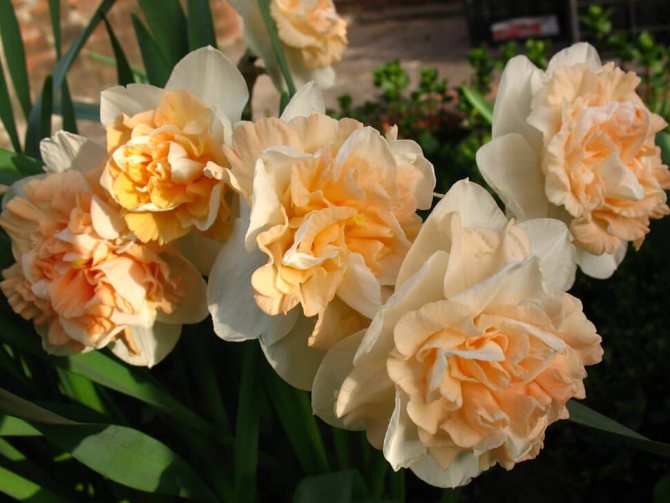

The “terry” cap of the daffodil justifies the name with its appearance and adorns a high peduncle. The perianth is white and yellow, the crown is red, milky or deep orange. The terry look grows beautifully, is unpretentious and looks spectacular on any of the flower beds. The most common varieties: Modern, Indiana, Golden Ducket, Beauty Exotic, Texas, Replit, Menly.
Group 5. Triandrus daffodils
On a low (25cm) peduncle, there are two or more flowers, the perianth lobes are slightly thrown back, the flowers are drooping (hanging). The color of the flower is white, yellow, golden. They bloom early, are suitable for planting among stones, go well with other early flowering bulbous plants.
|
|
Cyclamen daffodils
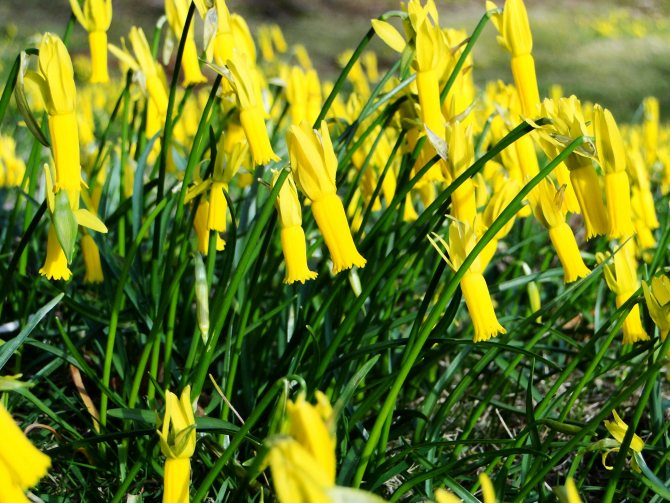

Reaches a height of 22 cm, and is similar to a cyclamen flower. The daffodil flower itself looks down, the petals bristle up. The middle is lighter than the main shade, long and thin. Blooms early and gets along well with neighbors in the flower bed. The leaves are long and thin, prone to lodging. Common varieties: Jenny, Tet-a-Tet, Baby Doll, Jack Sneel, Andalusia.
Container for planting
Narcissus roots need room for reproduction and growth, so pots or containers need to be at least 15-20 cm wide and 30-35 cm high. For small varieties that grow no higher than 15 cm, you can take smaller containers, but still with sufficient depth for rooting. It is impossible to overdo it on this issue, since excess space can harm the plant, delaying its flowering. The container can be ceramic or glass, wooden boxes are also suitable. Drainage in the bottom is required to drain excess moisture, it will prevent rotting in the onions.
Split-crowned daffodils
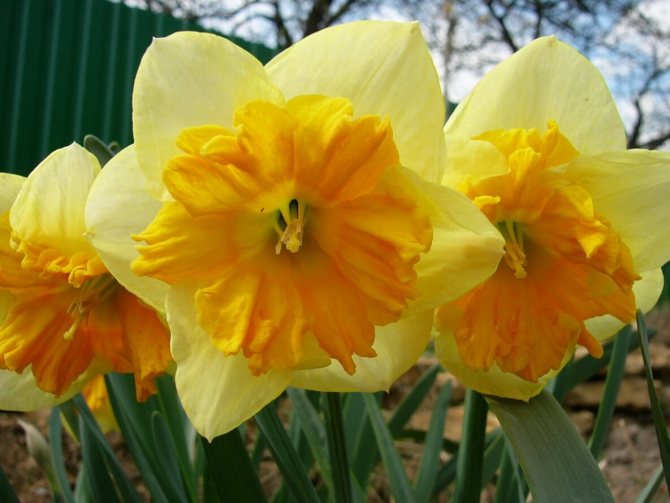

It will not be possible to pass by the split-crown daffodils. Their brightness and unusual appearance attracts the attention of others.
The center of the flower has a split crown, creating a volume effect. The color palette of the species is varied. Narcissus of this species grows up to 20-25 cm. The peduncle is decorated with a single flower 11.5 cm in diameter. Common varieties: Lemon Beauty, Split Crown, Size King, Chantarel, Modesta, Cassata.
Yellow daffodil
The species and varieties of daffodils shown in the photo are distinguished by a yellow inflorescence. The first appearance of the plant dates back to 1500; it was brought to our region from France, Italy and Germany. In the wild, it feels great on the slopes of the Caucasian mountains.


This daffodil grows small - up to 30 cm. Reproduction occurs in round (sometimes oval) bulbs, about 5 cm in diameter. The leg with the flower grows above the leaves, when opened, the petals reach a diameter of 4 cm. The core is in the shape of a crown, the edge of which has a corrugated structure. Flowering begins on the 15th of May and lasts 14 days.
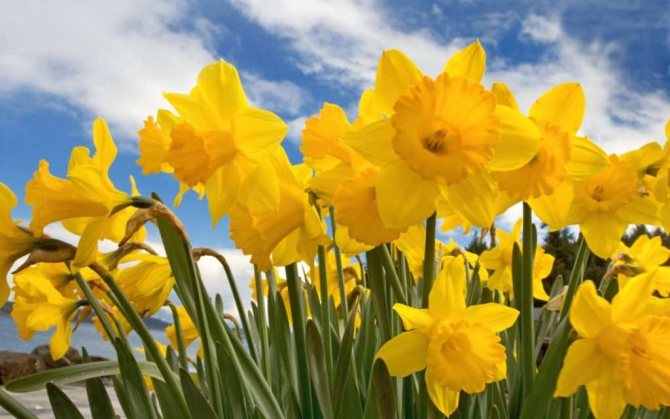

During the rapid growth phase, the plant releases dark green sheds, which will end up 10 cm below the flowers. Many other types of daffodils have been bred from this variety. They are used to decorate home gardens, gardens with rocky soil. Usually planted as neighbors for tulips, the royal crown and other mixed plantings, in which the juniper takes the central place.
Jonquilla daffodils
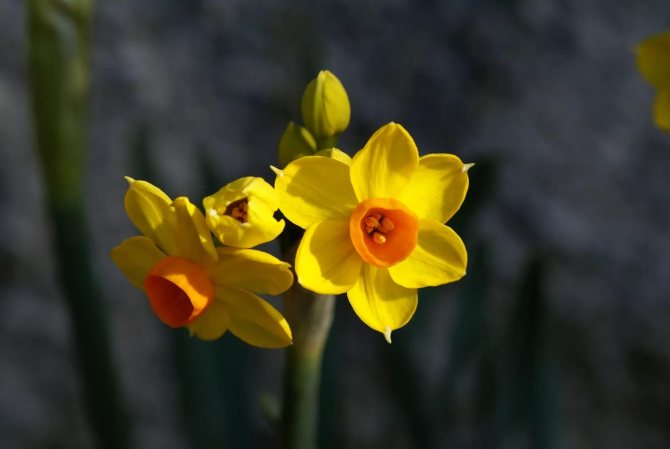

Another representative of daffodils, has more than five small flowers on the peduncle, with a shortened, rounded, convex center and long, thin leaves. The species is common in the temperate latitudes of our country. The colors of the jonquille daffodil are varied, with yellow, milky and pale orange shades.
Common varieties include: Star Hill, Sweetness, Golden, Susie Cherry, Belle Zong and the most beautiful instance of Baby Moon.
Pruning daffodils
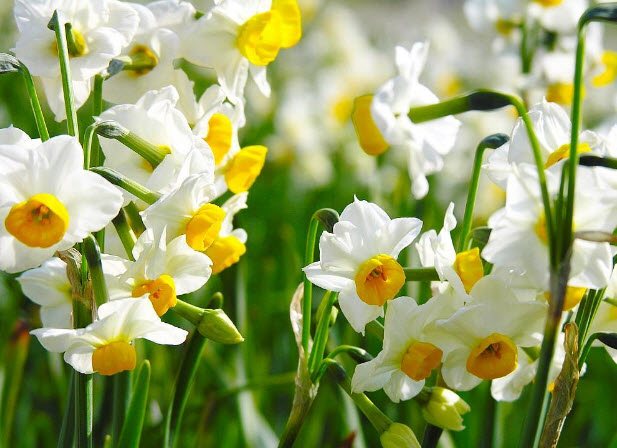

Formative pruning of the plant is not carried out. Moreover, they try to preserve the green mass of the plant as long as possible - until it dries out completely naturally. For forcing plants and open field plants, peduncles are pruned to obtain bouquet material.
Cutting method
The flower stalks of the daffodil are leafless, therefore, the removal of a flower during the growth process is well tolerated - the plant does not spend energy on setting and ripening fruits, the work of the entire vegetative mass is redirected to creating stocks in the bulb.
Peduncles have long been more likely to break out, rather than cut off. This is believed to reduce the possibility of virus transfer from plant to plant. At the base of the bulb, the peduncle can be easily separated without a knife.
Daffodils for a bouquet are harvested in the morning or in the evening, in the phase of a colored bud or in half-release. If transportation and storage are to be carried out, then the flowers are immediately wrapped in paper and sent to a very cool place - the lower the positive temperature, and the less its fluctuations, the longer the plant will stay in suspended animation, without losing the quality of further flowering.
Tubular daffodils
One of the largest and most common groups of narcissists. The middle of the flower is tubular. Early flowering, wide variety of varieties.
The flower is large, on a long stem, the leaves reach a height of 21 cm.
The tube and the main shade of the flower come in different shades. The species is unpretentious, decorative and sustainable. Common varieties are:
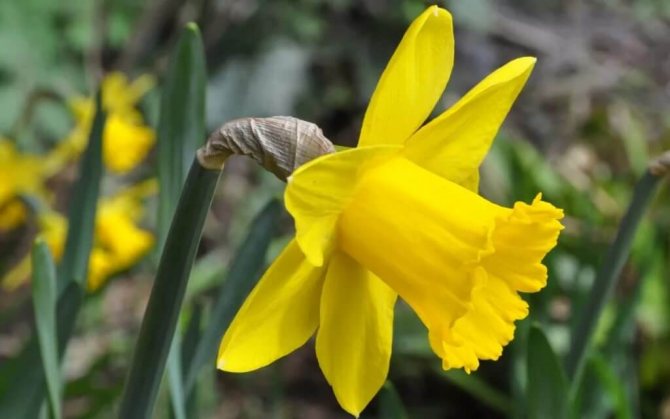

Golden Harvis, Celebrity, Christian Andersen, Bonnet, Golden Stark, Mount Hood, Musical Hall, Little Jame, Lunar Sea.
How to choose daffodil bulbs?
If you are not yet growing daffodils on your property and need to purchase bulbs, take a good look at them when you buy them. If it's soft, don't buy it. It is also important to inspect the bottom of the bulb, to check how smooth and dense the neck of the bulb is. It should be dense, without signs of wilting, rot and moldy smell, and the bottom should be dry. Choosing the right bulb will ensure that the daffodil grows well and blooms abundantly. Florists advise against purchasing bulbs:
- during the spring
- those that were dug with a stem, root, flower, when the plant was still in bloom or immediately after its end
- with prominent sprouts
- with a lot of small bulbs around the mother
- after strong, stable cold weather has come and the soil has already had time to freeze


Large-crowned daffodils
They justify their name with a large convex crown. The flower is large, bright yellow or white. Crowns are found in a diverse palette. The peduncle grows up to 35 cm, surrounded by narrow and long leaves. Large-crown daffodils are very popular among flower growers and are represented by varieties: Smagard, Lagerlef, Cardinal, Velaxes,
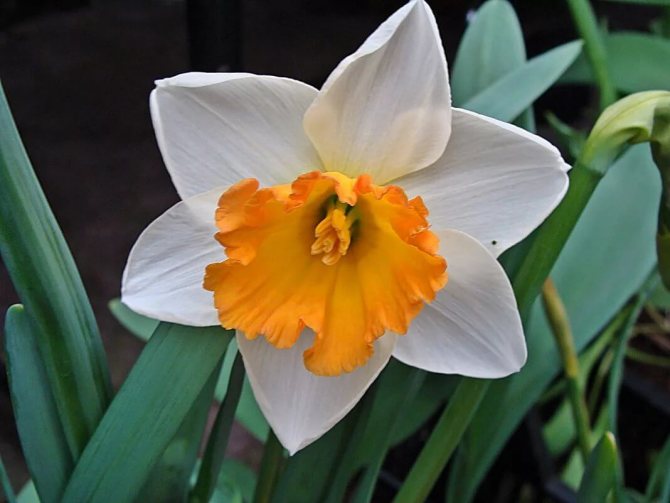

Progress, Sound Semiramis, Flower Shea, Royal Orange, Scarlet, Lady Bird, Kentucky.
Reproduction by small bulbs
You learned how to plant large bulbs in the previous section, in this e we will tell you what to do with small ones. In principle, the propagation process of the bulbs has already taken place, but you can use the remaining bulbs, from which you can form a regular-sized bulb. This method is not very popular and growers use it quite rarely, because it takes time and effort, but besides that, it is considered simple and effective.
You need to plant the babies of the mother bulb immediately after you dig them up. If you are going to send them far away, for example, for sale, for prevention, it is recommended to dry them and peel them of dry leaves and roots. You need to plant small onions in rows or in holes, while making sure not to confuse different daffodils.The optimum distance between the rows is 20 cm, the distance between the bulbs themselves may be less. Before planting the bulbs in rows or holes, the planting sites must be watered, then spread out the bulbs, sprinkle with soil and water again. Then you need to sprinkle a little more with dry soil. Later you need to water the plants, loosen the soil, getting rid of weeds. In general, caring for daffodils is very simple.
Poetic daffodils
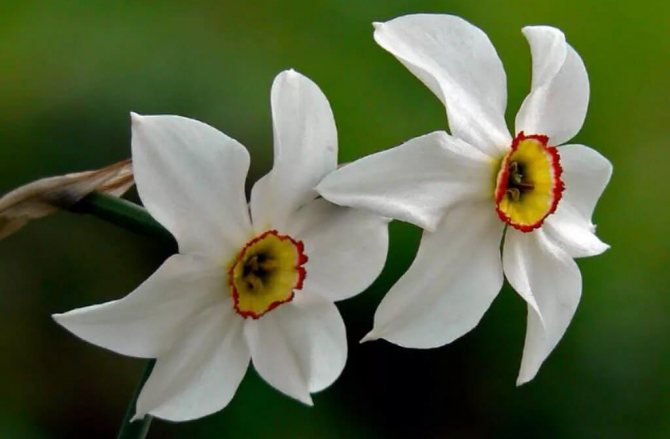

The grace and sophisticated look of the daffodil disposes at first sight. It blooms with white, neat inflorescences with a short, framed by bright red, skirt-shaped crown.
The flower is crowned with a tall and thin stem up to 38 cm. Delicate spring aroma and pearly whiteness of petals will not leave indifferent any grower. The most successful garden varieties are: Actea, Rome, Margaret Mitchell, Milan and Beauty.
White daffodil
This flower continues the list of species of daffodils (with photos and names). As a culture, it was bred in 1579, and imported from the Iberian Islands. In the wild, it can be found in mountainous areas with a lot of grass cover. In an adult state, the plant grows to a height of 35 cm. Reproduction occurs in spherical bulbs with a diameter of 4 cm. The leaves are similar to the varieties described above, the peduncle stalk does not grow higher than 23 cm.
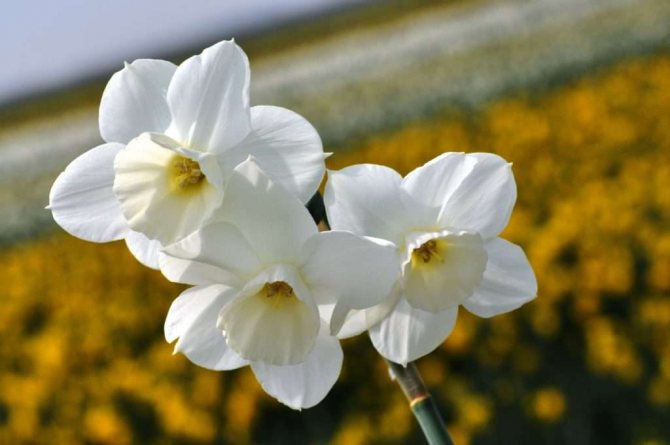

The flower itself is completely white. In contrast to the poetic narcissist, here the inner crown is of the same color, without a pronounced outline. The phase of active growth begins in mid-spring, and flowering occurs at the end of May. The blooming period of a flower lasts no more than 10 days.
Multiflorous daffodils
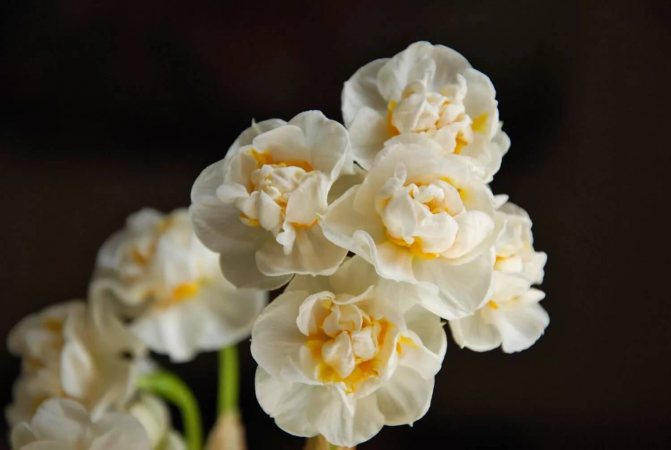

One peduncle of this species accommodates about 8 flowers. The appearance of the multiflorous daffodil is unusual and gorgeous, due to the accuracy and splendor of the inflorescences. The colors in their variety can be found as pale peach, white, and yellow. Despite its appearance, the species is not capricious and stable. Common varieties: Medusa, Minnow, Laurent Koster, Scarlet Jam, Elvira, Geranium, Chefulness.
Daffodil varieties
Multiflorous daffodils
Narcissus multiflorous - this is a real success of breeders. A whole bouquet on one peduncle! Effectively overcame in single plantings, in a cut. When planted in groups, it adds density and saturation to flower plantings.
Terry daffodils
TO terry daffodils plants from different groups belong, so here you can find varieties with single flowers and multi-flowered specimens. But they all have one thing in common - the thick openwork caps of the petals. Excellent decoration for garden paths and flower beds, good for cutting.
Orchid daffodils (Split Crown)
Orchid daffodils have an unusual and very elegant look, which is created thanks to dissected crowns of a wide variety of shades and shapes. These varieties are simply breathtaking! The perfect choice for creating a fantastic spring flower bed.
Daffodils tubular (large-crowned)
Tubular daffodils differ from other varieties by elongated tubes of different colors and shapes. Elegant and graceful, they are widely used in landscaping and for cutting. Daffodils of tubular varieties tend to have large bulbs and reproduce well.
In our online store you can buy daffodil bulbsgrown in the best European nurseries. We hope that the impressive assortment and affordable prices will inspire you to create unique spring compositions!
Cyclamenous plants. Group 6
This includes cyclamen daffodils. They usually have a single drooping flower on the stem. The varieties of this group were obtained by crossing the species cyclamen-like daffodil and cultivated forms of the plant. As a result, plants were created with a thin crown, which sometimes exceeds the length of the perianth.
The petals of these varieties are bent back, and the flowers in their shape resemble cyclamen. The most common group 6 daffodils are:
1. Jetfire. The flower of this daffodil has a diameter of 7.5 cm.Its perianth segments are bright yellow and rounded. The petals are slightly bent back. The tube of the flower is bright orange with a dark corrugated edge. This variety belongs to the early ones. 2. Baby Dol. This variety of daffodils has a bright yellow perianth. The tube is slightly ribbed and cylindrical. Its edge is corrugated, and the color is orange-yellow.
How to provide narcissus with wintering conditions


By itself, the daffodil bulb can easily withstand frosts under a layer of snow and sit out the winter without much difficulty. But recently, snow in many regions has ceased to fall in sufficient quantities, and periods of thaws are destroying the plant, since a daffodil who feels warmth can begin to grow earlier than the required period and die in severe frost.
To prevent this, you need to thoroughly clean the land where the daffodils stay for the winter, loosen it and cover it with a 15 cm layer of mulching mixture. These can be fallen leaves, ash, straw, peat, etc. Mulching is performed closer to the frost period, and this layer is removed immediately after the risk of severe frosts returning is behind.
More on planting and caring for a daffodil in this video:
Split-Corona
A very popular group of daffodils among gardeners. The flower is large, 10-12 cm, with a crown cut to more than 1/3 of its length (resembles a butterfly). Peduncle height 40-50cm. The colors are rich in combinations of several shades (usually three). Flowering: very early to late.
- ‘Pink Wonder’ (Narcissus Pink Wonder)
- ‘Ralmares’ (Narcissus Palmares)
- ‘Tricollet’ (Narcissus Tricollet)
- ‘Mondragon’ (Narcissus Mondragon)
- ‘Greenhouse’ (Narcissus Orangery)
- ‘Papillon Blank’ (Narcissus Papillon Blanc)
- ‘Valdrom’ (Narcissus Valdrome)
- 'Dolly Mollinger' (Narcissus Dolly Mollinger)
- ‘Cassata’ (Narcissus Cassata)
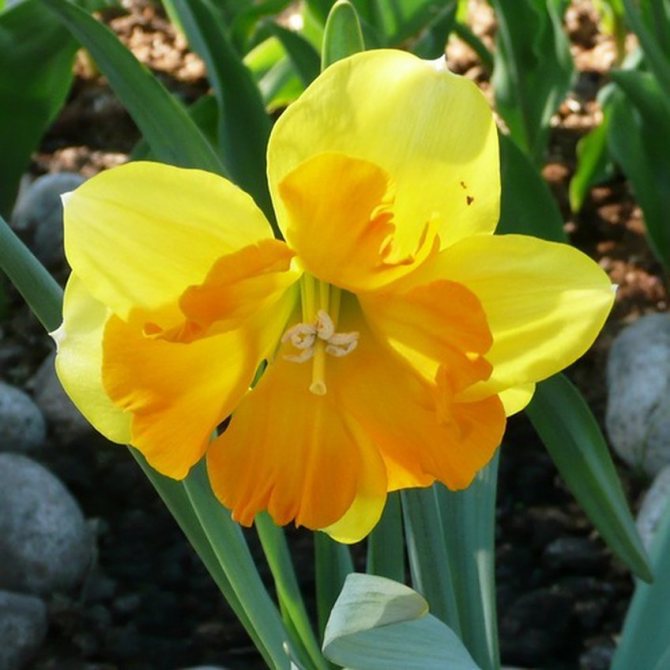

Harvesting the bulbs
Harvesting of bulbs is sometimes necessary for the sale of planting material of valuable or rare varieties, for reproduction and transplantation of plants.
When to dig up daffodils
Daffodil plants should be allowed to complete their growing season. When the bushes are still visible, it is advisable to install decorative markers in their places in the form of plastic or wooden signs of various colors.
The bulbs must be excavated after the leaves are completely dry.
Storing the bulbs
Storing daffodil bulbs consists of several steps:
- Analysis of the dug out bulbs. This stage includes sorting and selection of planting material for further purposes. This can be planting in flower beds, selling, forcing or growing.
- Drying by parsing. It is carried out in a dry room at an air temperature of 24-25 ° C for 7-10 days. The light regime during this period does not matter.
- Storage in the cellar. It is best to store the bulbs in wet sand at temperatures between 10 and 16C.
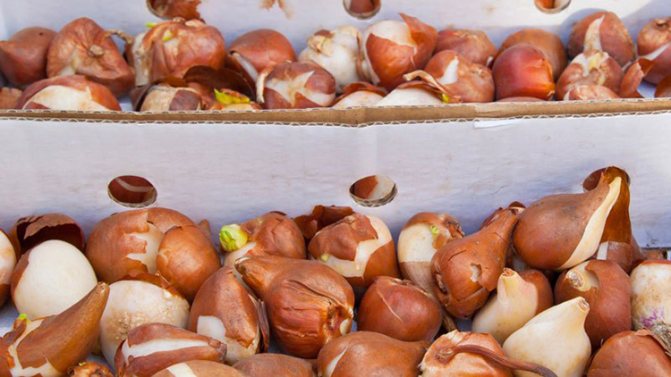

In the absence of a cellar, it is permissible to store daffodils in the refrigerator in the vegetable compartment. However, in modern refrigerators, the planting material dries up a lot. To prevent the bulbs from drying out, they can be placed in plastic bags with holes, and you should regularly check for mold growth in the bags.
The shelf life varies. For autumn planting, it is 1.5-2 months, for spring planting - up to 8 months.
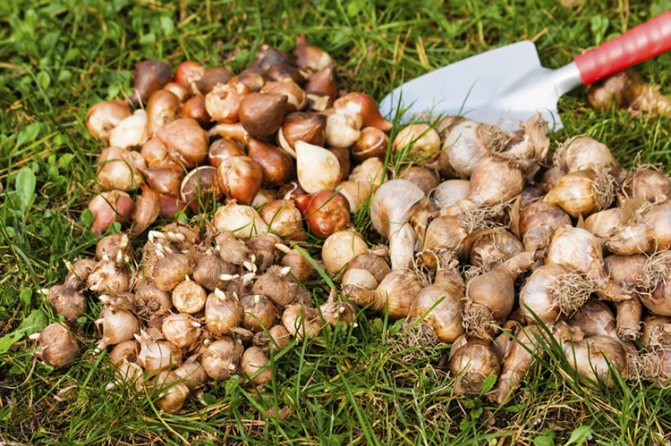

Soil preparation
The most suitable for growing daffodils are loamy soils with a neutral or close reaction of the environment.
If the soil on the site is too light, sandy, then you need to add a fine and dense fraction to it - clay. If the soil, on the other hand, is too compacted, caked and dull, then river sand is added to it. On acidic soils, liming is performed in the season preceding the planting of daffodils. 200-400 g of slaked lime is applied per 1 m2 of the garden.
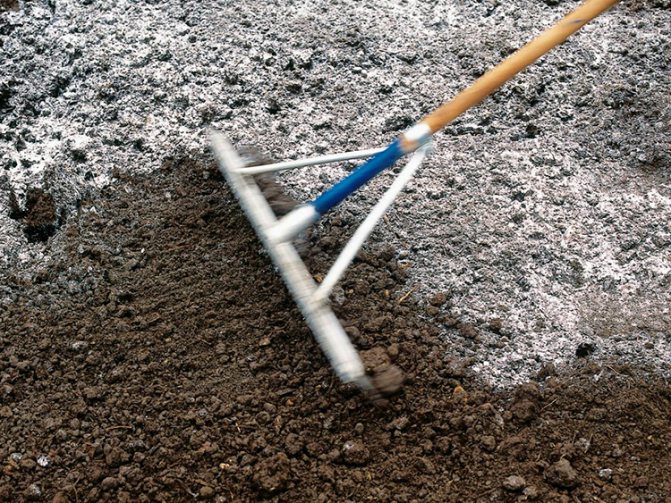

In addition, for each square meter of the garden, 3-4 kg of humus and fertilizer must be applied:
- if the garden bed is being prepared for spring planting, then a complete mineral fertilizer is added to the mixture, for example, azofoska;
- if the garden is being prepared for planting daffodils in the fall, then you only need to add phosphorus and potassium, for example, in the form of superphosphate and potassium chloride or sulfate.
The ingredients introduced must be evenly distributed over the surface of the garden bed and dug onto a shovel bayonet. The bed is now completely ready for planting daffodil bulbs.
The latest daffodils
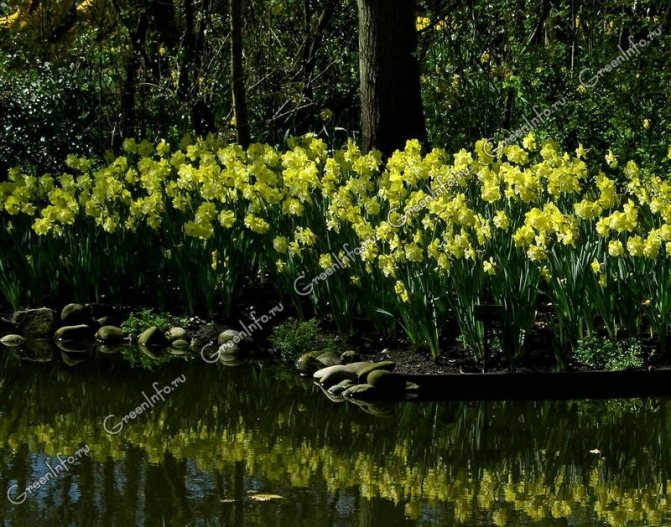

Narcissus Pineapple Prince
Narcissus is no longer an outlandish overseas flower. It is found in almost all gardens and is not difficult to grow as it has adapted well to our harsh climate. And although there are many varieties that bloom together or much later than most traditional tulip varieties, we still associate the arrival of early spring with delicate and fragrant daffodils. Daffodils belong to the amaryllis family. In nature, up to 60 of them are known, and in culture there are already several thousand varieties, but every year some interesting novelties appear.
The first in the gallery of new products is the Taurus cultivar, which belongs to the group of split-crown daffodils. Its large, split crown changes its color from bright yellow with a pink rim to almost completely pink within a few days! The snow-white Trepolo variety with a bright yellow-orange central star or Apple Pie, Apricot Whirl, Valdrome or Walz varieties can compete well. The height of the Trepolo daffodil is medium, 30-40 cm, the rest - 40-45 cm. It is impossible not to mention the beautiful new Sunny Side Up variety - its chic corrugated lemon-yellow crown will not leave anyone indifferent! The variety blooms quite late, height 35-45 cm.
|
|
Among the large-crowned daffodils, there is also a novelty - the Professor Einstein daffodil with a bright orange crown in the center of the flower. See how solemnly and gracefully he presents his beauty against the background of red imperial tulips, which only emphasize their aristocratic origin! Flowering quite early, height 35-40 cm. Or, for example, the Pink Charm variety is pure white with a light creamy pink crown, which over time is gaining an ever brighter pink hue. Very good material for various floristic compositions and good resistance to bad weather. The height of the flower is slightly above average, 40-45 cm. Flowering usually occurs in the middle of the season. The Sentinel variety is also very beautiful in its own way, with a very large pink crown. The height of the peduncles is 35-40 cm, flowering is medium-late.
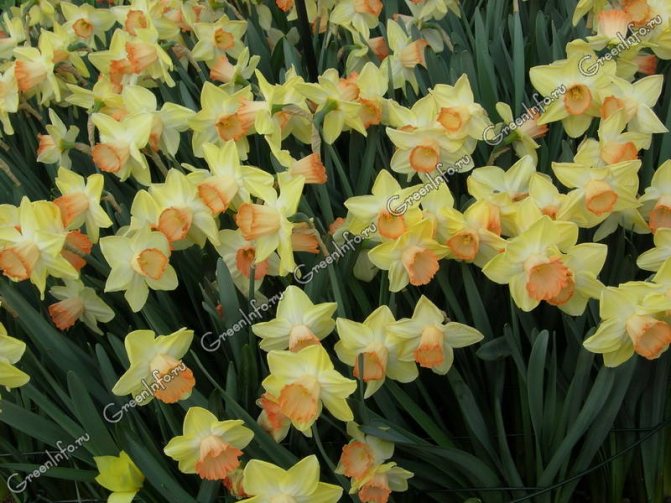

Narcissus KV12
Or maybe you prefer the tubular Peaches and Cream, which also changes the color of the center from beige-pink to bright orange-pink? An excellent choice for curbs, rocky slides, and retaining walls. Next to it or against the background of violoka and muscari, the lime-lemon Snow Frills variety with an elegant white center or the white-yellow Salome variety will look quite stylish. Or, for example, a completely new variety that does not yet even have a registered trade name and is shown at exhibitions under the name KV12. His crown is salmon pink against the background of a white central part and pale yellow petals. All varieties are stocky enough, only 25-35 cm high. This makes them good candidates for planting in rockeries, rock gardens or just separate groups on the lawn or on gentle slopes. Flowering is medium late.
Standing apart among the tubular daffodils is the chic, delicately lemon-lime large-flowered Pineapple Prince with a graceful white rim around the edge of the large central tube. Flowering later, it is quite tall, the height of the peduncles is 45-55 cm. Excellent cutting! There are other worthy new varieties, for example, Topolino, W.P. Milner, Wisley. They are a little smaller in stature, and their flowers are noticeably smaller, but look how elegant they look in a flower bed or in a composition in a floor vase!
Among the double daffodils, there is simply a huge replenishment - this is a tall yellow variety Clear Day with an orange-pink double center, and a lemon-yellow Fashion Parade with a darker center, but lighter tips of the petals, and a large-flowered variety Acropolis. It is, so to speak, densely doubled and almost completely snow-white with a small orange "edge". And how beautiful is the peach-beige variety Angelica with an open orange center! A little apart is the shorter and perhaps not so large, but no less beautiful snow-white daffodil Gay Challenger. Which one is better, you choose, our dear reader. For me, they are all beautiful in their own way and will be very appropriate in various parts of your garden.
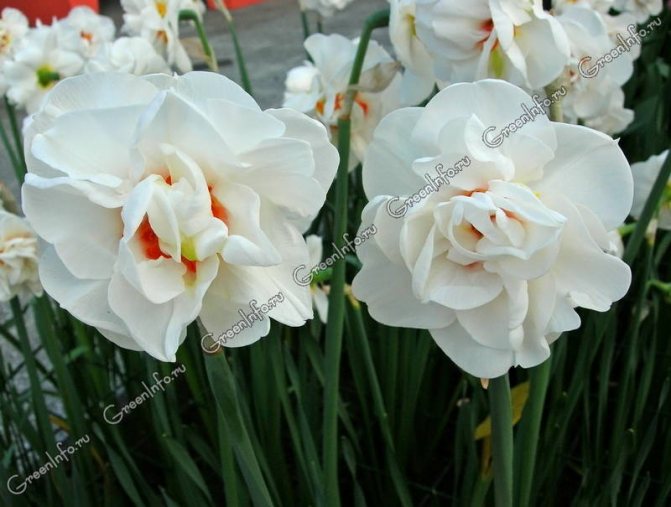

Narcissus Acropolis
A special group is made up of daffodils with a double center. For example, the Wave variety has a very original flower shape. This is a novelty for the last two years. It has a beautiful and very strongly doubled center, consisting of bright yellow and white tightly folded inner petals. The Modern Art variety has the same or almost the same flower shape. It has been on our market for much longer, although it can also be attributed to the novelties of the XXI century. It has a very beautiful combination of lemon yellow petals and a dark orange center. Both varieties look very good when cut. I highly recommend it! The height in the open field is 35-45 cm, in the closed field it can be slightly higher. Flowering medium-late.
Among the novelties among cyclamen-shaped daffodils, I would like to mention the very graceful and elegant variety Cotinga with small white petals bent back and soft salmon centers, or, for example, the Sailboat variety with soft lemon centers. Like all daffodils of this group, these varieties bloom early enough and are short, only 15-25 cm in height. The low height and abundant early flowering make it possible to combine this variety with very early tulips, such as the Plaisir tulip.
I would like to say a few words about the very beautiful, but rarely widespread or simply unknown in our country, Irene Copeland. It belongs to terry varieties and is no longer a novelty. But look how amazingly elegant it looks along the usual footpath near the office! And imagine how these daffodils will bloom at your edge or along the entire perimeter of your site!
|
|
There are novelties in the camp of poetic daffodils. Recently, a beautiful large-flowered variety Margaret Mitchell has appeared on the market in its own way, with a very beautiful lemon-yellow center and delicate red edging. It will look great both on the plot and in the cut! Its height is 40-45 cm, flowering later.
For lovers of multi-flowered daffodils, I can recommend the rich yellow Martinette with a bright orange center. The number of flowers on its peduncle can vary from 3 to 5. The height of the peduncle is highly dependent on the light and the planting site and can reach 35-60 cm. Flowering in the middle of the season. The daffodil Ziva has even more flowers on one peduncle. Its pale white caps on rather high, 40-45 cm, peduncles can have more than ten beautiful flowers! It blooms quite late, so it can be combined with many medium and late flowering tulip varieties.
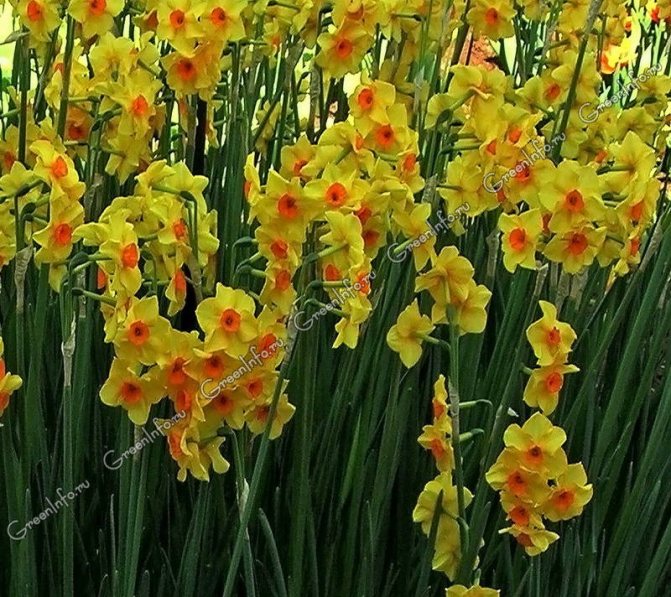

Narcissus Martinette
The use of daffodils is very versatile - from planting in regular park beds to growing on alpine slides, mixborders and patio containers. And how beautiful they look in the cut! Daffodils will look very stylish in large floor vases near your home or cafe, and in ordinary neat pots or pots near your gazebo. It is perfectly acceptable to just plant them under a tree or along the foundation of your garden house, steps or hedges. They will look appropriate in large flat floor vases on pedestrian alleys and near artificial reservoirs.
Can you imagine a whole blue river of blue Armenian Muscari (Muscari armenicum) with banks of bright yellow or white daffodils Peeping Tom? Moreover, this "river" appears completely unexpectedly and just as unexpectedly disappears after 2-3 weeks. Compare the two below photos. They are taken at intervals of only 8 days. And in a couple of days, bright tulips of the Rob Verlinden variety will bloom in the same place and this colorful show will last at least 8-10 days!


Narcissus Peeping Tom and Armenian Muscari (Muscari armeniacum)
This idea can be used with other, later varieties. For example, the yellow daffodils of the Quail variety and the later Muscari variety Bicolor will work well. And finally, can these varieties be evenly mixed? and then your show will run for over a month! In subsequent years, this effect will only intensify, since these crops should not be disturbed for several years and they will only grow! Can you imagine if, interspersed with muscari, you also add bright crocuses that bloom much earlier? I assure you that an abundance of bright, cheerful colors is provided for you for many, many weeks! You just have to take care of your "river" or a self-assembled carpet - at least occasionally water in dry weather, occasionally feed and remove already faded flowers.
And how they effectively set off and emphasize the beauty of mixed park or garden curbs, neatly trimmed shrubs or even ordinary park benches! For example, the Modoc variety. He will surely stir up your pleasant nostalgic or, on the contrary, romantic memories. If you prefer undersized varieties, Jetfire and Itzim are the best choices. Daffodils look very refined and stylish against the background of ordinary, but well-trimmed and well-groomed bright green lawns or silvery conifers.
This culture goes well with other small-bulbous: Scylla, Pushkinia, Anemones and Chionodox. Looks beautiful together with the Replete variety and the dark blue Chionodoxa Magic Blue! Medium-sized or dwarf daffodils are an excellent pair for blue, red-brown or burgundy viols, as well as early low-growing tulips. They will look very stylish with bright white arabis or white and pink saxifrage.
|
|
Daffodils are not too demanding on the soil. Light to medium loams with good drainage are most suitable for them. They do not tolerate fresh manure well and prefer near-neutral soil acidity. Therefore, it is possible to introduce rotted manure, compost, as well as liming only ahead of time under the previous culture. The soil for planting is dug to a depth of 30-35 cm, adding coarse sand, peat and superphosphate if necessary. Before planting, it is better to dig up the soil again, removing the sprouted weeds.
The planting depth of bulbous is usually three of their bulb diameters, counting from the bottom. It also depends on the local climatic conditions (winter hardiness zone), the type of soil and the purpose of your planting. In harsher climates, the bulbs are planted a little deeper. The distance between the bulbs is approximately equal to two of its diameters.
In the spring, immediately after the snow melts, daffodils are fed with nitrogen fertilizers. If there is hot, dry weather for more than two weeks in spring or summer, then they should be watered abundantly. After three weeks, it is advisable to apply phosphorus and potash fertilizers, you can add a little ash.
If this is necessary, then the daffodil bulbs are dug up in July, when the leaves have already dried up. If no digging is planned, the dried leaves are carefully removed and, if possible, loosen the ground around the plantings, preventing wireworms and perennial weeds from developing. Towards autumn, if the weather is dry, watering should be resumed to help the bulbs take root.
|
|
It is believed that the best time to plant daffodils is from mid-August to late September, and in the southern regions until mid-October. But this is in theory, in practice, everything, as a rule, is a little more complicated. That landing site is not ready - dahlias or annual asters are still blooming there, then suddenly it is very cold and there are prolonged rains. Or there is simply no way to get out on the "right" weekend at the dacha. And finally, there is such a magic word "sale", which for some reason always happens only in the second half of October or even in November!
Plant daffodils when you have the opportunity. Although it is clear that this is best done at positive temperatures. You will not only please yourself and those around you, but also banally save from death the bulbs of daffodils, tulips, crocuses and other small-bulbous plants that have already been prepared for decommissioning from death.
It is for the reasons listed above that my numerous friends and I repeatedly planted daffodils both in November and December at temperatures close to zero, or even at low freezing temperatures, practically in snow or under a 2-3-mm crust of ice, but also under snow. Somehow I had to plant a mixture of pink-crowned daffodils bought at a sale, even at -3 ° C. I raked the snowdrift as best I could, dug a sufficiently deep hole, covered the bulbs half with snow, half with earth, and again poured a huge snowdrift on top. And what do you think - next year they bloomed beautifully, however, a week and a half later than the rest of the daffodils. So that's the beauty of it! During flowering, I calmly sorted them into varieties and then safely transplanted them to a permanent place.
Good luck with your experiments and unusual solutions in growing these unusually beautiful and sunny plants!
Photo by the author
Possible growing problems
There are a variety of reasons why daffodils did not bloom. Heat-loving varieties are afraid of recurrent frosts. The frozen capsule dries up without blooming. It is useless to wait for flowers from small-sized varietal bulbs, they need to grow for at least 5, and sometimes 7 years. Small-bulbous bloom in the third year. Planting density negatively affects. When daffodils grow, some of the bulbs should be transplanted.
Leaf problems
If the leaf begins to turn yellow during the growth of the flowering arrow, it is recommended to check the acidity of the soil. The plant loves neutral soil. Perhaps the cause is a root infection.
Important! After lodging, it is advisable to cut off the greens so that the earth is ventilated.
Pests
It is not advisable to grow onions on a feather or turnip near flowering bulbous crops. The onion fly lays the larvae on the buds. She is destroyed by Fufanon. Acaricidal preparations are effective against root mites and nematodes. Traps save the bears from slugs.
Other daffodils
Here are united daffodils that were not included in the previous classes.
"Jumblie"
Strong dwarf hybrid with several peduncles about 18 cm long and 1-3 flowers per peduncle. The crown is a deep golden color surrounded by lighter, narrower curved “petals”.
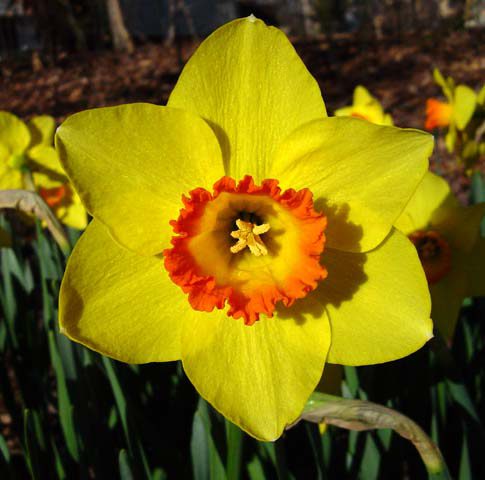

"Jumblie"
"Tete-a-Tete"
A dwarf hybrid with 1-3 small yellow flowers on a 15 cm peduncle. These two varieties are quite winter-hardy, but in the middle lane, the bulbs become smaller over time. By origin, they are close to Cyclamen daffodils.
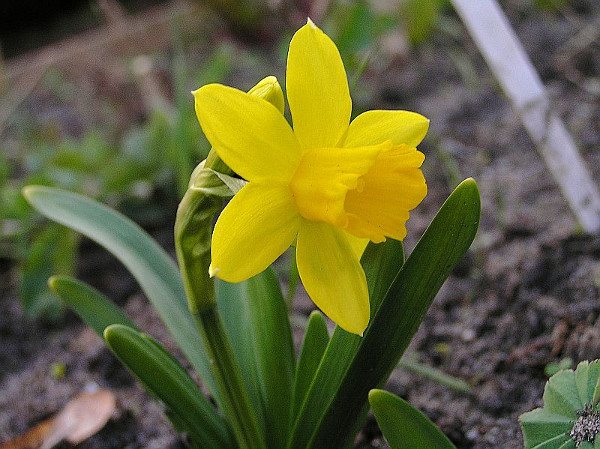

"Tete-a-Tete"
Benefits of daffodils for growing in the garden
The popularity of daffodils is associated not only with the wide variety of varieties that differ in height, color and flowering time. Gardeners appreciate the flower for the following reasons:
- the plant is not afraid of spring frosts and blooms earlier than tulips;
- bulbs can not be dug for five years;
- daffodils are suitable not only for landscaping the site, but also for growing in flowerpots in winter.
Daffodils are one of the most undemanding spring garden dwellers, for which it is easy to find conditions and just as easy to provide proper care.
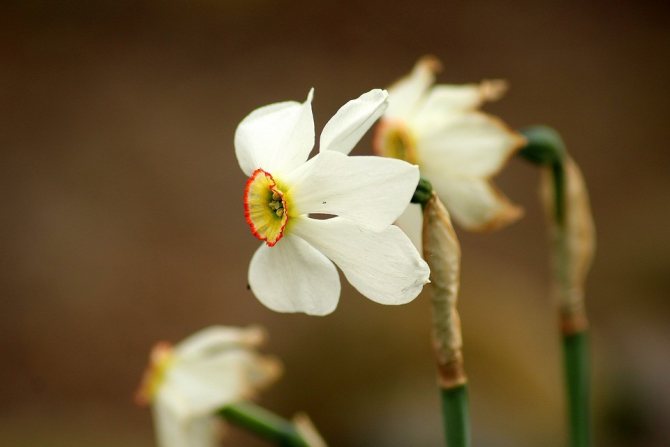

Post-flowering care
Immediately after flowering, the plants begin to reverse the flow of nutrients from the leaves into the bulbs. During this period, watering should be reduced with a complete cessation by the time the leaves wilt. In addition, the concentration of cell sap in the bulb gradually increases, and if watering is given at this time, it may decrease, which is undesirable.
It is necessary to loosen and level the soil to prevent the penetration of onion and daffodil flies into the bulbs.


Poetic (Poeticus)
Poetic daffodils are characterized by a tall, up to 50 cm peduncle with one large flower 6-8 cm. The flowers are snow-white with a small crown in a bright yellow tone with a very bright edge. Daffodils are fragrant and have some of the latest flowering dates of all daffodils. Daffodil bloom period: May /
- ‘Aktay’ (Narcissus Actaea) - flowers 7 cm, white-milky shade with a bright yellow crown with a narrow rich red border. The flower stalk is strong, 30-40 cm high. Flowering: early May 12 days.
- ‘Red Rome’ (Narcissus Red Rim)
- ‘Sarchedon’ (Narcissus Sarchedon)
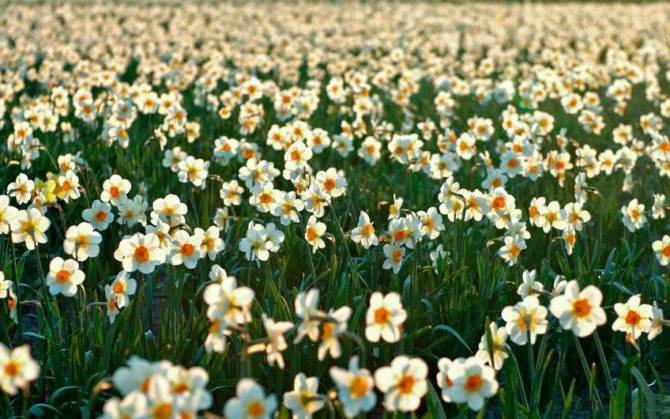

Jonquilla
Daffodils have several small flowers on a peduncle, a strong aroma and semi-cylindrical, arcuate-bent leaves. Flowers 4-7cm on a peduncle 25-35cm high. Bloom: April-June.
- ‘Sun Disc’ (Narcissus Sun Disc)
- ‘Sweetness’ (Narcissus Sweetness)
- ‘Step Forward’ (Narcissus Step Forward)
- ‘Baby Moon’ (Narcissus Baby Moon)
- ‘Quail’ (Narcissus Quail)
- ‘Pipit’ (Narcissus Pipit)
- ‘Susie’ (Narcissus Suzy)
- ‘Trevetian’ (Narcissus Trevethian)
- ‘Hillstar’ (Narcissus Hillstar)
- ‘Bellsong’ (Narcissus Bellsong)
- ‘Dixissel’ (Narcissus Dickcissel)


Plant propagation
Transplanting daffodils is not necessary as long as you take good care of them all the time. A transplant is performed only in certain forced situations, this can be done about once every 4 years.
Flower propagation occurs only using babies and bulbs
... After the leaves turn yellow, you need to remove the bulbs. This must be done on time, because later the bulbs will begin to take root.
When the bulbs are dug up, the soil, leaves and old roots are immediately separated. Then you need to dry them for several days. After that, the daffodil bulbs carefully inspect and sort
according to the appropriate size, babies are also separated from the uterine bulbs. If damage or disease is found on the bulbs, then such narcissus bulbs are removed.
They are treated with a special "Hom" agent. Then they are dried for 10 days at a temperature of about 25 degrees. After that, the daffodil bulbs are placed in a specially designated place and stored at a temperature of 18 degrees until planting.
Whichever variety the daffodil is, planting and grooming requirements for daffodils remain unchanged
.
Narcissus is a typically perennial plant. In one place without a transplant, it can grow for 5-6 years. Plants should be transplanted when the bulbs, growing, begin to press against each other and the flowering weakens.
Daffodil bulbs
perennial, consist of a bottom, concentric storage scales, growing year after year, and dry brownish outer covering scales. Bulbs are single and multi-peaked, the latter consist of several bulbs with a common bottom and covering scales, from which several stems with flowers can grow. A multi-peaked bulb can be divided by cutting along the bottom, sprinkling the cuts with ash and holding for several days before planting.
The best time to purchase planting material is 3 months after flowering. For daffodils grown in the middle lane, this is mid-August and later. Earlier dates are possible for bulbs grown in the south of Russia or imported.
Buying bulbs in the first place pay attention to their density
(soft or dry are not suitable), cleanliness and integrity of the bottom, smoothness and density of the tops (necks).
Bulbs are not recommended
: - in spring; - excavated with stems, flowers, roots during or immediately after flowering; - those that have already shown a sprout; - multi-peaked, if one large onion is surrounded by numerous small ones; - after the onset of persistent cold weather and freezing of the soil.
Daffodil bulbs are planted in September. Choose a well-lit, wind-protected area for planting. The daffodil also feels great in light partial shade. In such conditions, he has a high peduncle, large and bright flowers. It blooms longer.
Narcissus can grow in almost any soil
- from sandy to clayey. But at the same time, it must be borne in mind that the arable layer must be at least 30 cm, it is to this depth that the roots of the narcissus extend. And don't forget to drain. For all his love for moisture, the daffodil does not tolerate stagnant water, his bulbs can rot.
In addition, they cannot be planted where daffodils were grown the day before (you can return to their original place in 5-6 years), lilies, tulips, onions and other bulbous crops, as well as phlox, perennial asters and chrysanthemums. Good predecessors are cereals, legumes, herbs, cucumbers, tomatoes, peonies.
Sand is added to heavy clay soils (20-30 kg per 1 sq. M), and to sandy soils - humus (up to 20 kg per 1 sq. M).
When planting daffodils, no way you can not add fresh manure to the soil
... It is brought in one year before planting at the rate of 15 kg per 1 sq. m. But this is not enough for daffodils. In June, when preparing the soil for daffodils, dig it up and add 50 g of superphosphate and 30 g of potassium salt to each square meter. It would be nice to add humus too.
It is best to plant daffodils immediately after digging - in mid-August. Daffodil bulbs do not store well. Unprotected by dense leathery scales, like a tulip, they evaporate a lot of moisture during storage. Before planting, the bulbs must be kept in a solution of foundation (0.2%) and rogor (0.3%) for 20-30 minutes. The bulb is planted to a depth equal to three of its heights, counting from the bottom. If the weather is hot, dry, then the daffodils should be watered. In the fall, before frosts, it is advisable to cover new plantings with a layer of peat or leaves. In the future, plants will not need shelters, with the exception of daffodils.
During the season, daffodils are fed 4 times
... The first three dressings - during germination, budding and flowering - are the same. Nitrophosphate is added each time. The first time - 100 g per 1 sq. m, and the next two times - 60-70 g per 1 sq. m. The fourth dressing is carried out after flowering and only phosphorus (2 parts) and potash (1 part) fertilizers are applied at the rate of 50-60 g per 1 sq. m. All top dressing is combined with watering, then the earth is loosened or mulched.
Narcissus is a moisture-loving plant
, it must be watered to the full depth of the roots (up to 2 buckets per 1 sq. m). Dig up daffodils as soon as the tips of the leaves turn yellow and the bush begins to decay. Do not expect the leaves to die off completely. In this case, the place where the bulbs are located will not be visible, and when they are excavated, they can be accidentally damaged.
If the daffodils remain for the next year, it is necessary, in June, after waiting for the leaves to die completely, to shovel them and carefully loosen the planting site.
Some growers advise to postpone the digging of daffodils to an earlier date, before the daffodil fly begins to fly, in order to avoid damage to the bulbs.
Dug out daffodils are immediately removed into the shade and carefully freed from the remnants of the earth, carrying out the first selection of diseased and damaged bulbs. Then washed with clean water and etched for 30
min in one of the phosphorus-containing solutions or with a 0.2-0.3% solution of foundationol.
Storage
- a very crucial period in the life of daffodil bulbs. Tulips and hyacinths, which need a higher temperature, are not company. Daffodils prefer coolness: until mid-August they will be quite satisfied with the 17-degree mark on the thermometer, and then even lower - up to 9 ° before landing.The humidity in the room should be moderate, sa-paradise somewhere in the shade with good ventilation is best. It is obligatory that the bulbs are examined twice a month and diseased ones are removed.
Growing beautiful daffodils in the garden
Growing daffodils in the country is very popular, both among gardeners and urban gardeners and landscape designers. Thanks to the delicate flowers that begin to bloom in early spring and become the first decoration of the garden, they are called "garden snowdrops".
Daffodils are not demanding to care for, but they need an individual approach, which is why when growing, questions arise: when to cut daffodils and whether they need to be dug out after flowering.
Growing daffodils in the country: where to plant daffodils
Daffodils are perennials, they are quite unpretentious. The best place to plant daffodils is a protected area from the wind, and they grow well both in the sun and in the shade. Wet areas are not suitable for growing daffodils in the open field, since if the groundwater level exceeds 50-60 cm, the delicate roots of the plants will rot and die off. After 4-5 years, daffodils begin to grow too densely, from which there are much fewer flowering plants. Then the landings need to be updated.
Daffodils bloom in April-May. Plants planted in autumn will bloom earlier than those planted in spring. The first to bloom are daffodils in a sunny place, and a little later in the shade. Forcing helps to speed up the onset of flowering, in this case flowers appear already in March - early April. It is recommended to remove faded heads if you do not need seeds.
If you remove the seed pods, the bulb will develop better, which can then be used for vegetative propagation.
Daffodils will decorate the lawn, flower beds, alpine slides, and they can also be used to decorate a garden path along the edges. Daffodils will make a wonderful duet with tulips, moreover, these plants tolerate each other well.
Among other things, daffodils also protect against mice. The fact is that the roots and leaves of daffodils contain toxins, so rodents avoid them.
Look at the photo: daffodils create an excellent protective barrier for the entire flower garden. They are also good for planting near fruit trees as additional protection against voles.
To create the impression of a natural array of flowers, you can use the following method: the bulbs are scattered in a chaotic manner, and then they are planted at the place of their fall, while adhering to the required distance between plants and the depth of the holes.
Narcissus description
The plant is perennial, herbaceous. Has basal leaves of a linear appearance. The buds are large, there are both single specimens and carpal assemblies. They have a delicate aroma, slightly drooping in shape, 6 cm in diameter. It is a decorative flower, especially in early summer - late spring, yellow and white shades prevail. The very first representatives of this beautiful plant begin to bloom as soon as the snow melts. They have white petals. Soon they are replaced by more beautiful varieties with large flowers.
Preparing for winter
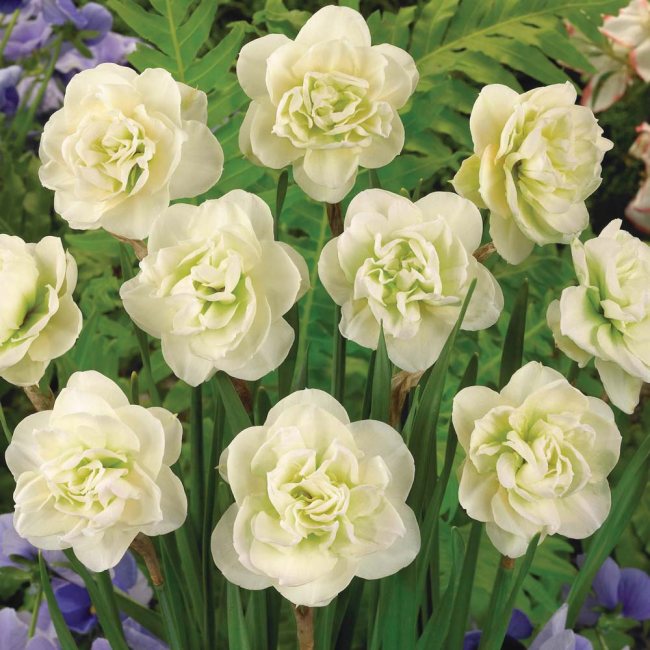

Terry varieties need special care in winter.
Daffodils are resistant to low temperatures, but deep freezing of the soil in winter can kill the bulbs. As well as thaws, due to which the plant begins to wake up, and after the return of cold weather dies.
To protect tubers that hibernate in the ground, the following preliminary work must be carried out at the end of autumn:
- clear the beds from wilted leaves and stems
- gently loosen the beds
- cover with a layer of peat, straw, sawdust or fallen leaves 15 cm high
You can remove the mulch in the spring, when the risk of frost return completely disappears.
A flower garden with varieties of low winter hardiness, especially double and daffodil daffodils, must be covered for the winter with agrofibre or spruce branches.
back to menu ↑
See also: What to plant under the trees: flowers, plants or vegetables? In the garden or garden in the shade (40+ Photos & Videos) + Reviews
Terry (Double)
- ‘Cheerfulness’ - fragrant flowers (5cm), raceme 3-5-flowered. The color is white with a cream shade. Peduncle height 25-30cm. Bloom: May - 10 days
- Inglescombe- flowers (8cm), lemon-yellow tone. Plant height 35-40cm. Flowering: early May -10 days
- 'Indian Chief'- flower 7 cm. Yellow-orange daffodil. Peduncle height 25-30cm. Flowering: early May - 8-10 days
- ‘Hollands Glory’ - a large flower (8-9cm) of light yellow color. Peduncle height up to 35 cm.Flowering: early May - 8 days
- 'Tahiti' - flowers (up to 10 cm) with bright yellow petals and an orange corrugated crown with copper-red strokes, fragrant. Height 40cm. Bloom: March-April


Pink daffodils
These are amazing flowers, the magical beauty of which can amaze anyone. The pink-crowned daffodil was first bred in 1921 by an Englishwoman, Mrs Beckhouse. And even then it became a sensation. The first pink daffodil was the progenitor of various varieties and hybrids.
And today they continue to be called "pink daffodils", the varieties of which belong to different groups according to the International Classifier. Such exquisite flowers are found in groups of double and tubular, jonquil and cyclamen, as well as split-crown. These are Pita, Sheri, Audubon and many others.
Advice
If the soil in your garden is loose, prepared for planting, you can save time and energy by using a simple device.
Alternatively, choose a peg slightly larger in diameter than the bulbs you are planting. Mark the desired planting depth on it and start making holes, deepening the peg to the mark. For convenience, swing the peg to the sides a little, then it will be convenient for you to put the onion there. We fall asleep with earth and spill. Planting time is reduced several times!


Why don't daffodils bloom?
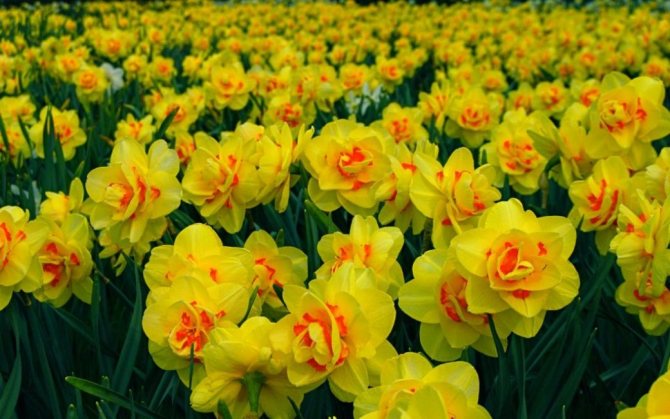

The plant does not always bloom profusely, even with proper care.
Even with the observance of all the rules of agricultural technology, some gardeners sometimes do not bloom healthy sprouted daffodil bulbs.
There may be several reasons for this phenomenon:
1First year after transplant. Plants may simply not have time to take root and throw all their strength on rooting, and not on flowering.
2High acidity of the soil. It is recommended to alkalize the soil by introducing wood ash at the rate of 200 g per 1 m2 or the same amount of chalk, dolomite or lime flour.
3 Close planting of bulbs. Plant roots are intertwined, competing for nutrients and moisture, so the flowers do not set.
4 Lack of nutrients. After the end of flowering, the plants are fertilized every year.
5 Excess nitrogen in top dressing. Nitrogen fertilizers will help to achieve beautiful, juicy leaves, but they do not contribute to the flowering of daffodils.
6Early pruning of leaves. Due to the absence of the process of photosynthesis, a flower embryo is not formed in the bulb.
7 Shady place for a flower garden and insufficient watering. Excess moisture is also dangerous, due to which the plant bulb can rot.
8 Diseases and pests that feed on embryonic scales.
back to menu ↑
See also: [VIDEO] What to do with the lawn in spring?
Description of the plant
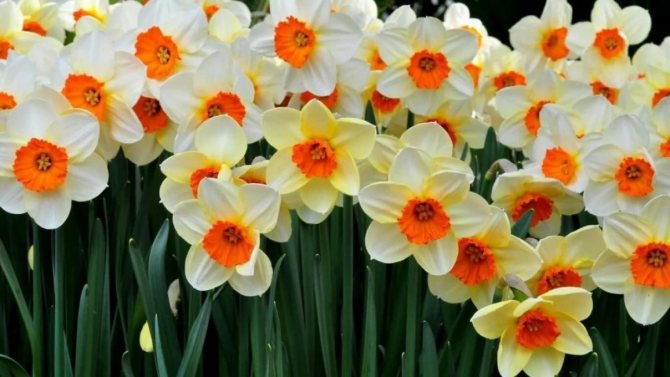

A distinctive feature of spring flowers is the contrasting color of the petals and perianth
Narcissus is a monocotyledonous perennial of the Amaryllis family, which is able to bloom profusely in one place for up to 5 years.
1Leaves plants, linear, basal, appear before the peduncle. The flower appears at the top of a leafless stem of a round or flattened shape, it can be single or can be found in an umbellate cluster of 2-8 inflorescences.
2Bulbs perennial, most often elongated, round or ovoid, in brown scales.
3Roots reach lengths up to 70 cm, white and threadlike.
4Flowers most often have the shape of a bell of white or yellow color from 6 petals with a brighter shade of the perianth (crown). They can be simple and terry and are usually short - from 10 cm to 60 cm, and the fruit of the plant is a box of 3 nests with seeds.
Depending on the timing of flowering, daffodils are distinguished:
- early (end of April - first days of May)
- early-middle (May 5-12)
- medium (15-20 May)
- medium late (after May 21)
- late (June)
- blooming in autumn (do not grow in central Russia)
There are 13 garden groups, which differ in shape, color and size of flower and stems, flowering time and other features. There are more than 60 natural flower species, and there are about 30 thousand hybrid garden forms.
Daffodils are unpretentious flowers which do not require too careful maintenance, and feel great both outdoors and in a flowerpot on the windowsill. However, in order for the plant to please with abundant flowering, it is necessary to take into account the recommendations and rules of agricultural technology.
back to menu ↑
See also: [Instructions] How to feed tomatoes after planting in the greenhouse, in the ground so that they are plump and tasty + Reviews
Classification
Today, gardeners know more than sixty names of natural species, as well as hundreds of names of hybrids and varieties of daffodil. How not to get confused in this numerous list? For this, experts have developed the International Classification of Daffodils. A huge number of forms of this flower were divided into 13 groups.
The varieties of daffodils, photos and names that can be found in this article give a vivid idea of the available forms of these amazing flowers.
According to the International Classifier, each group has its own numerical designation. When daffodils are described, the varieties have a specific code. It starts with the group number. Then, through the dash, follows the color combination that the crowns and perianth lobes have. Also, the code uses the initial letters of English words, which denote the color of the daffodil. For example, if it is white, then there is the letter w, if yellow - y, pink - p, orange - o, red - r, green - g.
Origin
Daffodils are perennial bulbous plants. They belong to the amaryllis family. Where did the narcissist come from? The species and varieties of this flower are mostly from the Mediterranean. China and Central Asia are considered the birthplace of some of them.
For many millennia, the daffodil has remained one of the most pleasing and exciting spring flowers for humans. In the East, he is even compared with the bottomlessly beautiful gaze of a beloved. Every country has its own myths and legends about the narcissist. This amazing flower is also depicted in the paintings of many artists. You can find it on other objects of art.
Europeans have always considered the daffodil a talisman capable of attracting love. In Italy, the spring flower is a symbol of passion.
Since ancient times, daffodil has been used in the creation of perfumery products. He also found application in medicine. The essential oils of this plant and the alkaloid substance narcissin, contained in the flower bulbs, were considered healing.
The beneficial qualities of the flower have not been forgotten today. For example, it is massively grown in China and other states of the East. It is required to obtain natural essential oil. Without a fragrant narcissus, it is impossible to imagine the New Year in China. The inhabitants of this country decorate their homes with bright flowers.
The British also love daffodils. Varieties and various types of this bright plant, in terms of their popularity, even managed to press the recognized queen of the garden - the rose.
Amazing properties of the flower
The essential oils contained in flowers have long attracted perfumers and medical professionals.Narcissus is recognized as a talisman, bewitching the opposite sex. To enhance the effect, alkaloid substances were used, which are contained in the bulbs of plants. By distillation, juice was extracted and dissolved in water, which men drank, hoping to increase potency, and women washed their breasts with this water, thereby increasing their attractiveness.
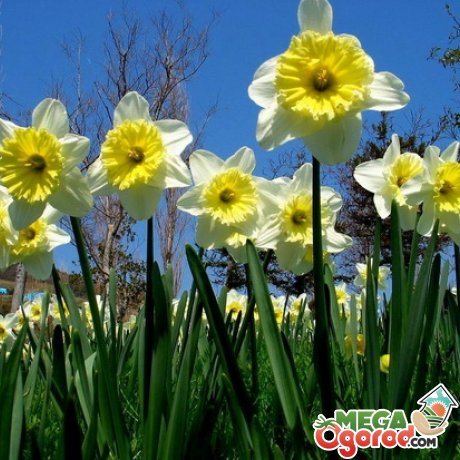

Ancient Eastern healers treated mastitis with a composition of peeled, finely chopped daffodil bulbs, adding rye flour or thick rice porridge. The mixture was applied to the chest, kept until a dried crust formed, which was washed off with warm water. The procedure was repeated twice a day.
It should be remembered that the bulbs of daffodils are very poisonous, they can disrupt the work of the heart, provoking arrhythmias, cause indigestion and affect the nervous system, dulling, stupefying, acting like a drug. It is therefore advisable to transplant plants with gloves in order to exclude direct contact with the skin, protecting it from allergic reactions and dermatitis.
Protection from pests and diseases
Onion Batun - growing from seeds
The most dangerous diseases for daffodils are various rot and fusarium. Plants are affected by pests such as:
- onion and lumpy hoverflies;
- slugs;
- narcissus fly;
- root or onion mite;
- nematode.
In the spring, before the formation of buds, the plantations are treated with appropriate insecticides and acaricides. In this case, it is necessary to strictly follow the instructions for use, trying not to exceed the concentration. When flowering is complete, the plants are sprayed with the following substances:
- copper sulfate (100 g of the drug per 10 l of water, 200 ml of working fluid per square meter);
- Hom (40 g / 10 l of water, the consumption rate is the same as in the previous case).


Copper sulfate
Various symbols
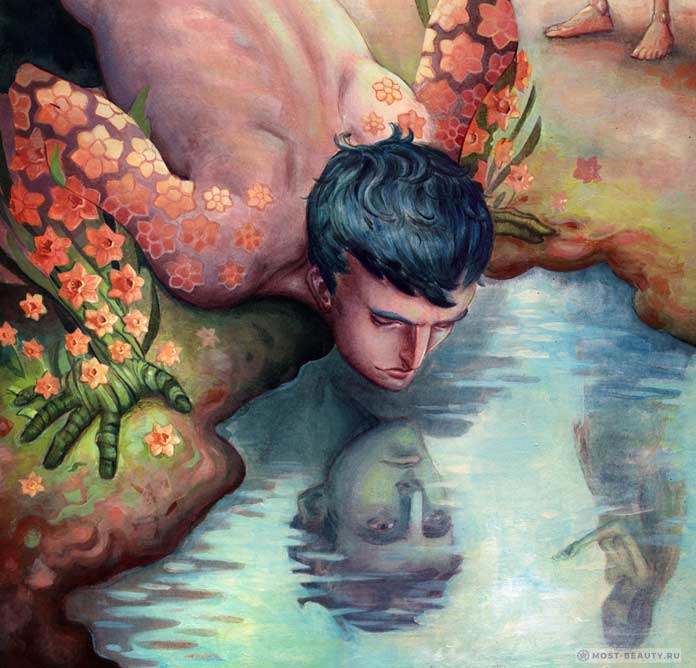

These flowers were admired by Shakespeare, Edgar Poe and Hafiz. In ancient Rome, they were considered a symbol of victory and were presented to the victorious warriors, and in Persian poetry they were compared with the languid gaze of a girl in love.
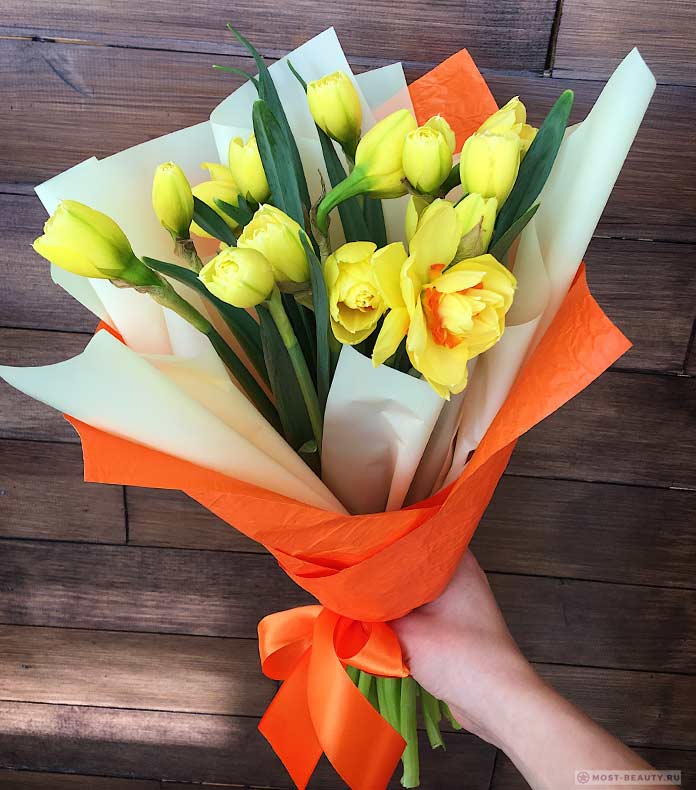

In Germany in the Middle Ages, the narcissist was associated with eternal love. It was customary to give a pot with it to the newlyweds to attract prosperity to the house. In China, these flowers still symbolize good luck and wealth. In England, they are more popular than roses, and in Wales they are even recognized as a national symbol.
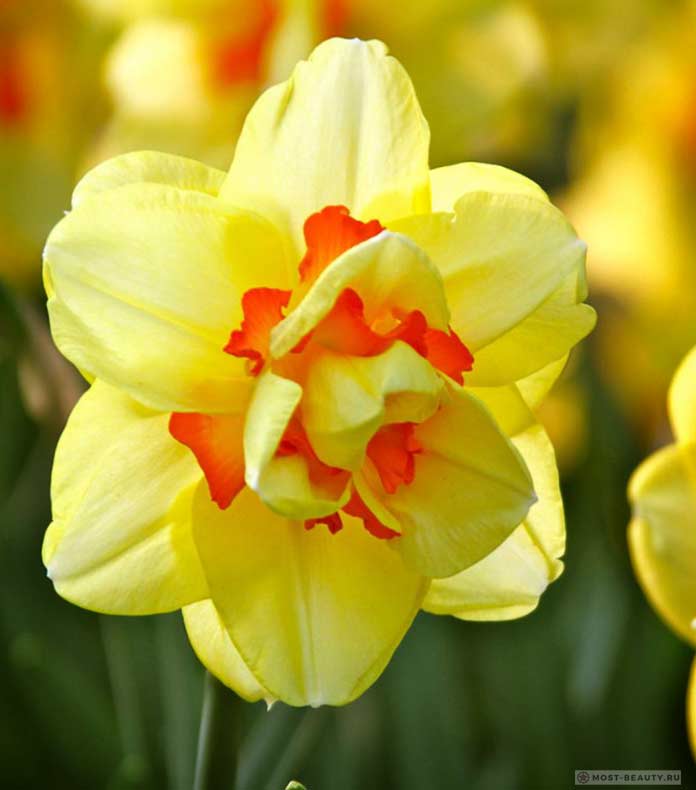

Daffodils have long been considered a symbol of rebirth and eternal unfading love, since their bulbs are preserved in the ground and every year they please again with colorful flowering. But ancient Greek myths surround the plant with the symbolism of a selfish nature. The theme of the legend is so popular that it can be traced in the canvases of many artists depicting a beautiful narcissistic young man who admires his reflection in a reservoir. In the neighborhood with him, the plant itself is always depicted, the origin of which is attributed to this myth.
Small-crowned representatives. Group 3
It includes daffodils, the varieties of which are of the small-crowned type. They are single flowers on a stem with a crown length not exceeding one third of the length of the petals. This group is dominated by varieties with a white-cream color. These plants are usually medium in size and have a delicate aroma of flowers.
The most popular varieties:
1. Amor. It is a huge white daffodil with a large crown, which is dominated by orange and red tones. 2. Audubon. The petals of this flower are white and the crown is creamy pink. 3. Edward Bukhton. The daffodils of this variety have a greenish-yellow funnel-shaped crown with wavy orange-yellow edges.
All of these varieties are intended for garden decoration and for forcing and cutting. Under the code 3-o-d there is a flower called Sabina Hey. These fabulously beautiful daffodils are late varieties. They have a deep red crown and an orange perianth.
Triandrus
Daffodils of this group are distinguished by a small crown and slightly bent perianth petals. Peduncle height -25-30cm with 2-6 flowers. Flowering: early.
- ‘Ice Wings’ (Narcissus Ice Wings)
- ‘Liberty Bells’ (Narcissus Liberty Bells)
- ‘Thalia’ (Narcissus Thalia)
- ‘Havera’ (Narcissus Hawera)
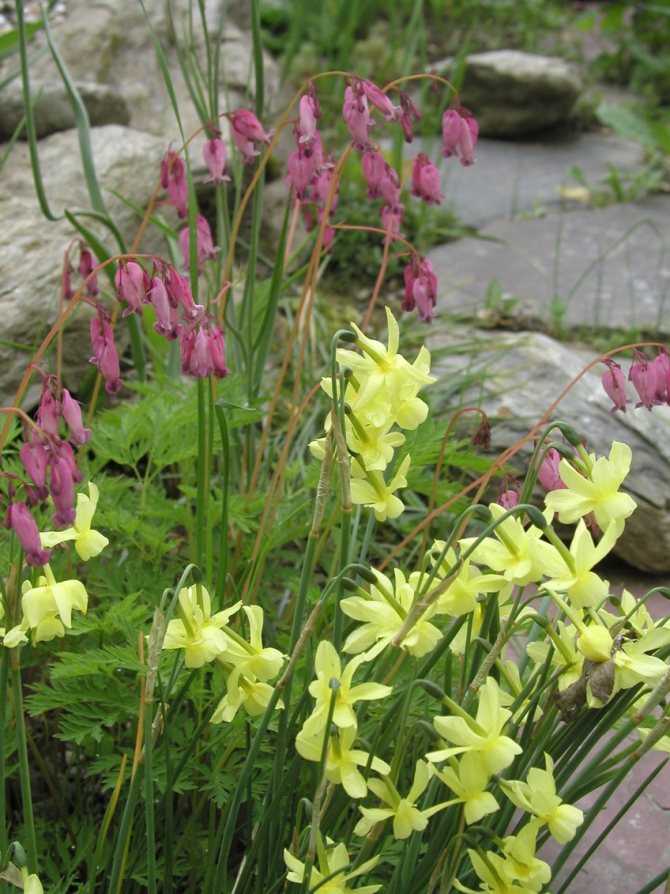

Description and features
Narcissus is a perennial bulbous plant that blooms in spring. The flower is easily recognizable: the well-defined perianth lobes frame a central cup-shaped or tube-like crown. There are usually 6 petals, but there are also double forms with petals of various shapes and sizes.
The classic daffodil, as most people imagine it, has white petals and a yellow center, although in fact, hybrid varieties come in a variety of shades.
Daffodils are used to frame curbs and flower beds in urban environments, as most varieties thrive in urban environments. Flowers are often grown in personal plots. Since plants are planted in autumn, usually from August, it is necessary to choose the species you like in advance.
How to grow daffodils outdoors
Seat selection
Daffodils prefer draft-free areas. In the presence of closely lying groundwater, a drainage system is required. Plants require areas of sufficient light, but the direct rays of the sun can destroy them. In this regard, the plot should be slightly shaded.
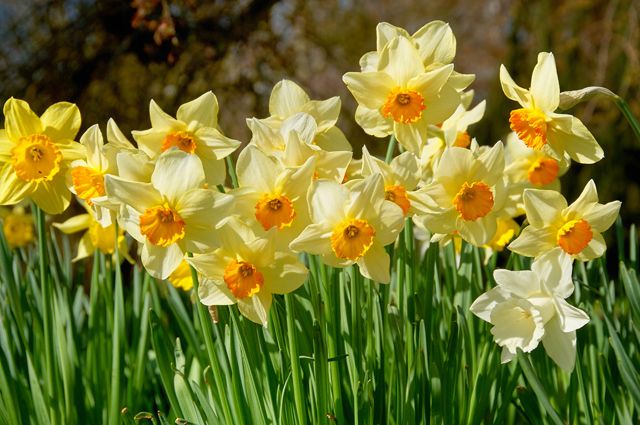

Growing daffodils
The soil must be water-absorbing and have a high degree of aeration. The acidity level should not exceed 7. Daffodils are able to develop normally alongside other bulbous plants, but these crops are not suitable as predecessors due to the presence of common infectious diseases.
Soil preparation
The optimal varieties of soil for daffodils are sandy loam and loam. Excessively heavy soils can be lightened with peat, which in the volume of half a bucket is applied to every square meter of the plot. After that, the plot is dug up and its surface is leveled. At the same time, it is recommended to saturate the soil with complex mineral fertilizers.
If the available soil does not meet the stated requirements for daffodils, you can independently make it more suitable for this crop. So, on chernozem soils, ground straw and river sand are introduced in a ratio of 2: 1. On clay soils, the land is improved with peat and sand, and on sandstones, special fertilizers are used, as well as black soil. In acidified areas, liming is carried out using wood ash or lime for this purpose.
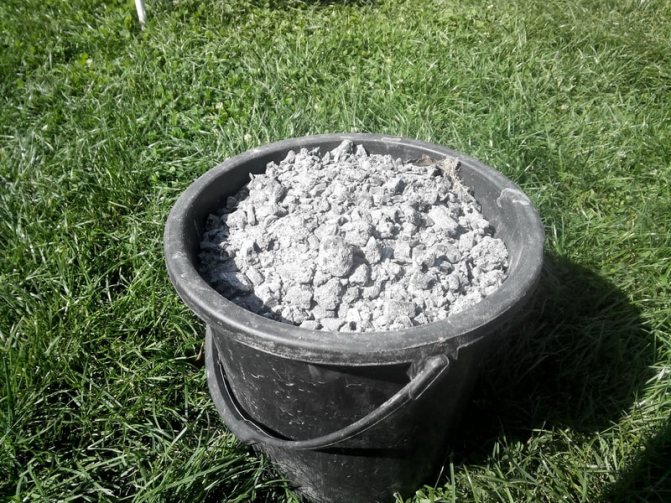

Wood ash
Daffodils are best and most conveniently cultivated in elevated furrows. To ensure the presence of such beds, it is required to prepare a soil mixture, which includes the following components:
- peat bog;
- black soil;
- river sand.
Rotten manure is added to the mixture, which has already lain for at least 5 years.
Important! Fresh manure is not used, it is able to burn the roots of plants.
On the basis of the mixture formed, the beds of the required height are poured, or the mixture is poured into special pallets knocked together from the boards. For each square meter of such soil, one tablespoon of phosphorus-potassium fertilizers is applied.
Preparation of planting material
For planting, only the best and fully formed bulbs are used, which are characterized by the correct shape and diameter of 6 cm. All substandard specimens, as well as sick and injured ones, are discarded. Selected bulbs are placed in a fabric bag with perlite for better preservation. Immediately before planting, the planting material is treated with fungicides.


Fungicide
Daffodils: Bulb cultivation
Depending on the weather and climatic conditions in the region of cultivation, the procedure is carried out in August-October.The bulbs take about a month to develop a sufficient root system. Plants should not be exposed to freezing temperatures this month.
Planting depths vary from 13 cm on heavier soils in warm climates to 26 cm in cold conditions on light soils. Freezing of the soil should not touch the planting material, as well as groundwater should not touch the bulbs. To facilitate the maintenance procedures, the row spacing is left equal to half a meter.
Important: for the formation of children with a larger size, the bulbs are planted closer to each other and embedded in the soil at a shallower depth.
To protect against freezing, mulching materials are used: peat mixed with straw and humus. At the onset of the first negative temperatures, the plantings are additionally covered with dried grass or straw. At the onset of spring, mulch and shelter must be removed as quickly as possible before they provoke rotting.
How to grow daffodils from seeds
Narcissus is planted with seeds, either when breeding wild specimens, or in selective breeding for planting the resulting hybrids. The seeds are placed in pre-prepared containers and grown at a temperature of about + 20C. After two weeks of growing seedlings, the temperature is gradually lowered to + 15C.
Additional information: this method differs in duration, since seed plants need to be grown for about 2-3 years before their full development begins.
Requirements for soil, site
Bulbous crops grow well in a sunny area without through winds. Slight penumbra is acceptable. Where moisture stagnates or groundwater is high, they will not grow - the bulbs rot from excess moisture.
If you make a choice between sandy and loamy soil, then the second option is more preferable - the sand freezes and the bulb can freeze, and the heat is retained better in the loam. Loamy soil conducts air and water well, warms up evenly.
The best soil option is loam with a neutral acidity index, to which nitroammofoska (60 g / m²) and humus (compost) are added.
Alkali will neutralize dolomite flour (200 g / m²), the acidity level will reduce the introduction of wood ash (1 tbsp / m²), and the sandy soil will be made heavier by the addition of a small amount of clay.
When choosing a site, you need to focus on predecessor crops. Planting after any bulbous, asters, chrysanthemums, phlox is not recommended due to the susceptibility of these plants to diseases, the pathogens of which can persist in the soil. After cereals, legumes, nightshades, you can plant.


If the accumulation of melt water is possible on the site, then you need to build a ridge with a drainage layer for the daffodils. To do this, they dug a depression, 30-40 cm high, pour a low layer of expanded clay, crushed stone or pebbles, sand (8-10 cm) and soil on top.
Large-crowned. Group 2
It includes large-crowned daffodils. The varieties of this group have a single white or yellow flower on the stem. Its diameter reaches 10 centimeters. The inflorescence of the large-crowned daffodil has six equal lobes and a corrugated tubular elongated crown of bright orange color. It is located on a stem, which has a length of 30-50 cm. What is the difference between such daffodils? Varieties of large-crowned plants have a smaller bulb than in the first group. Its diameter is approximately 3 cm.
The most popular varieties of large-crowned daffodils are:
1. Velazquez. It is distinguished by a large corrugated crown and color contrast. So, the crown of this daffodil has a bright orange color, and the petals are soft cream. 2. Carlton. This daffodil has a bright yellow inflorescence with a tubular, wavy yellow crown. 3. China made. This daffodil has both a crown and a delicate white color. But the variety also has a bright spot. This is the yellow wavy border of the crown. four.Professor Einstein. It is a snow-white daffodil with a fiery red crown. 5. Debutant. This variety is distinguished by a combination of snow-white petals with a deep pink crown.
Other popular varieties of large-crowned daffodils are Confuoco and Flower Record, Paola Verones and Rossi Sunrise, Kisprouf and others.
Reproduction
Like all bulbs, daffodils reproduce in two ways:
- seeds;
- daughter bulbs, children.
Bulbs
Most often, daffodils are propagated vegetatively or by children. On average, an adult bulb gives up to 4 babies per season. With good care and regular feeding, good varieties multiply faster - up to 6 babies per season.
Almost all bloom the next year. That is why they are planted immediately on a permanent site and leave enough space for the formation of clumps. Then the daffodils, year after year, delight with more and more flowers.
Any variety of these plants propagates with bulbs. This is done mainly when transplanting, observing a number of simple rules, which are detailed in the corresponding section.
Seeds
It is more difficult to propagate daffodils by seed.
It should be borne in mind that artificially bred hybrids do not retain varietal characteristics. As a result of sowing their seeds, you can get a completely unpredictable result.
This is how natural or wild-growing species are propagated, if it is not possible to transplant an adult curtain with the separation of children.
For seed propagation:
- the faded daffodil is not cut off, but the box with seeds is allowed to form and ripen;
- seeds are sown in the ground immediately after harvest, it is important to plant them fresh;
- the soil is loosened to a shallow depth and the seeds are embedded in it superficially, lightly sprinkled with earth.
Seeds are sown immediately in the garden or in flowerpots, taking into account the fact that the first two years, small bulbs cannot be touched. Such a plant will take 3 to 5 years to bloom. Therefore, breeders most often use seed reproduction of daffodils to breed new hybrids.
Distillation
Together with crocuses, hyacinths and tulips, daffodils are often used for forcing in winter.
To do this, take large, healthy bulbs and refrigerate them for at least three and a half months. The length of the peduncle depends on the temperature regime.
To begin with, all the bulbs are kept at a temperature of +17 ° C for about half a month.
If daffodils are driven out for cutting into bouquets, then the subsequent storage temperature of the bulbs should be +9 ° C, then the flower stalks of the plants will be long. For more compact peduncles, a lower temperature is required: from +2 to +5 ° C.
During cooling, it is necessary to ensure the maximum storage humidity - up to 95%.
After cooling, the bulbs are planted in pots prepared for distillation with light soil. You can use garden soil with sand.
After the plant starts growing, it needs to ensure timely watering and feeding.
Then a bouquet of fragrant daffodils will be a pleasant surprise for the New Year or any other holiday.

